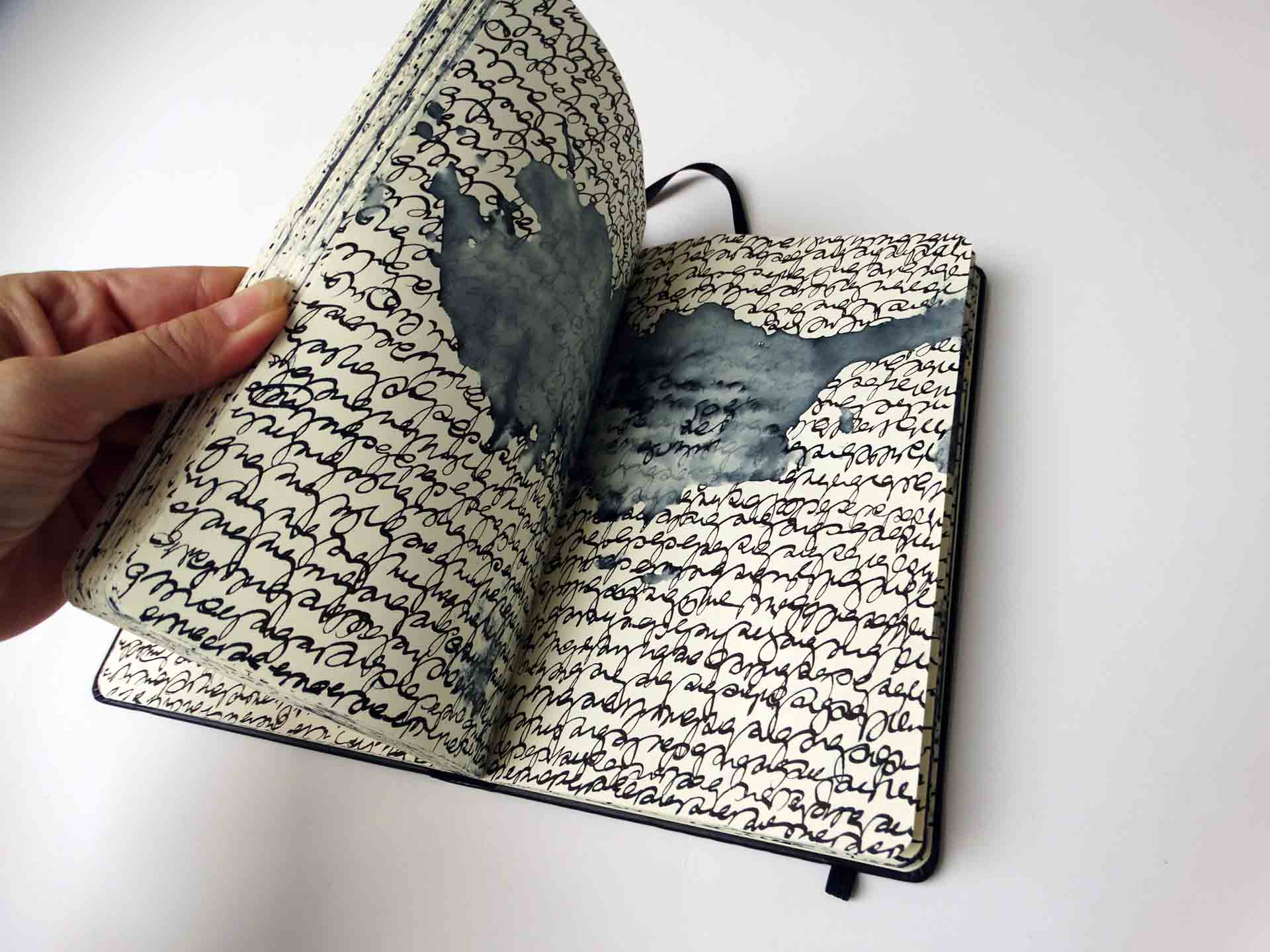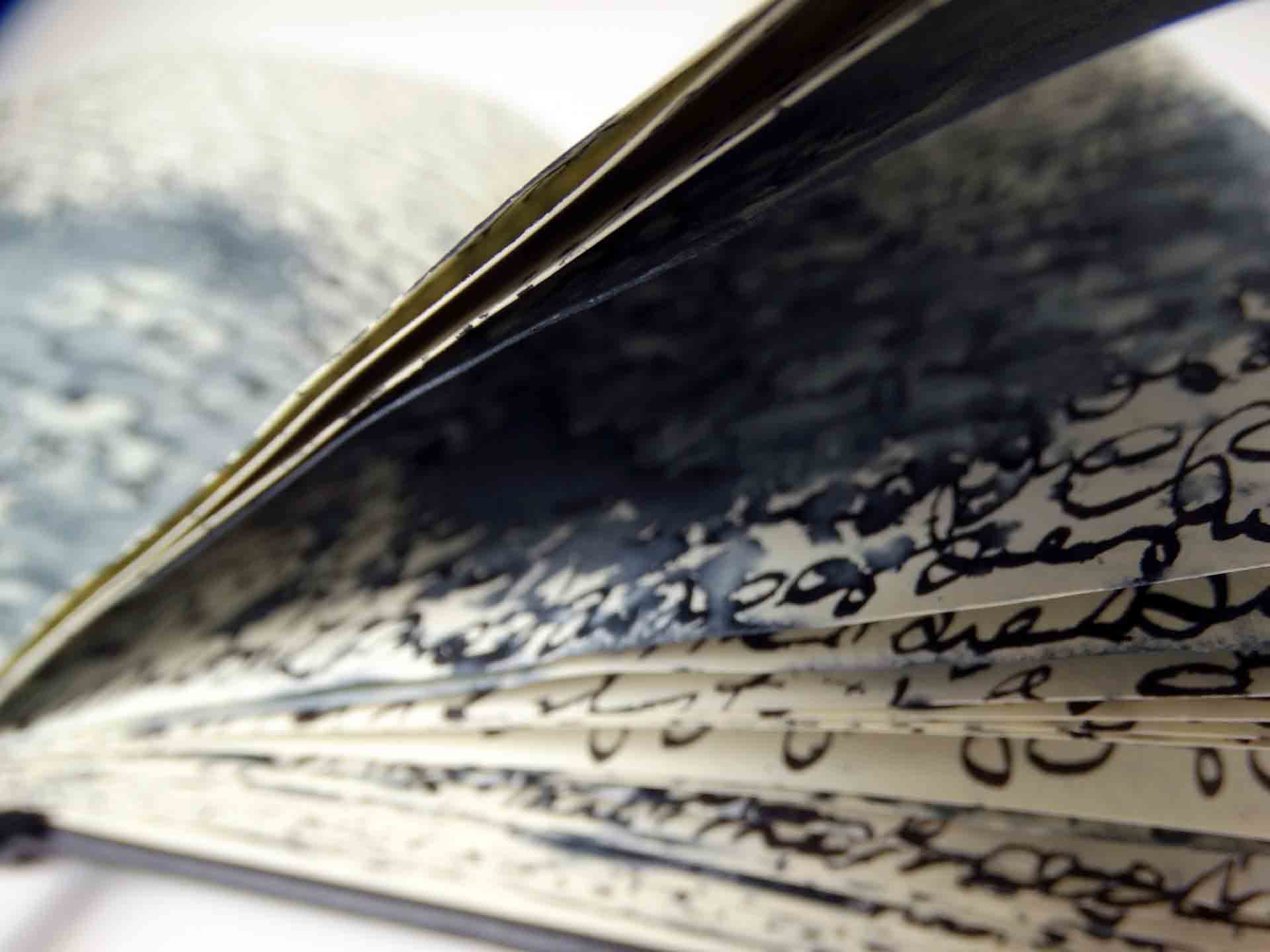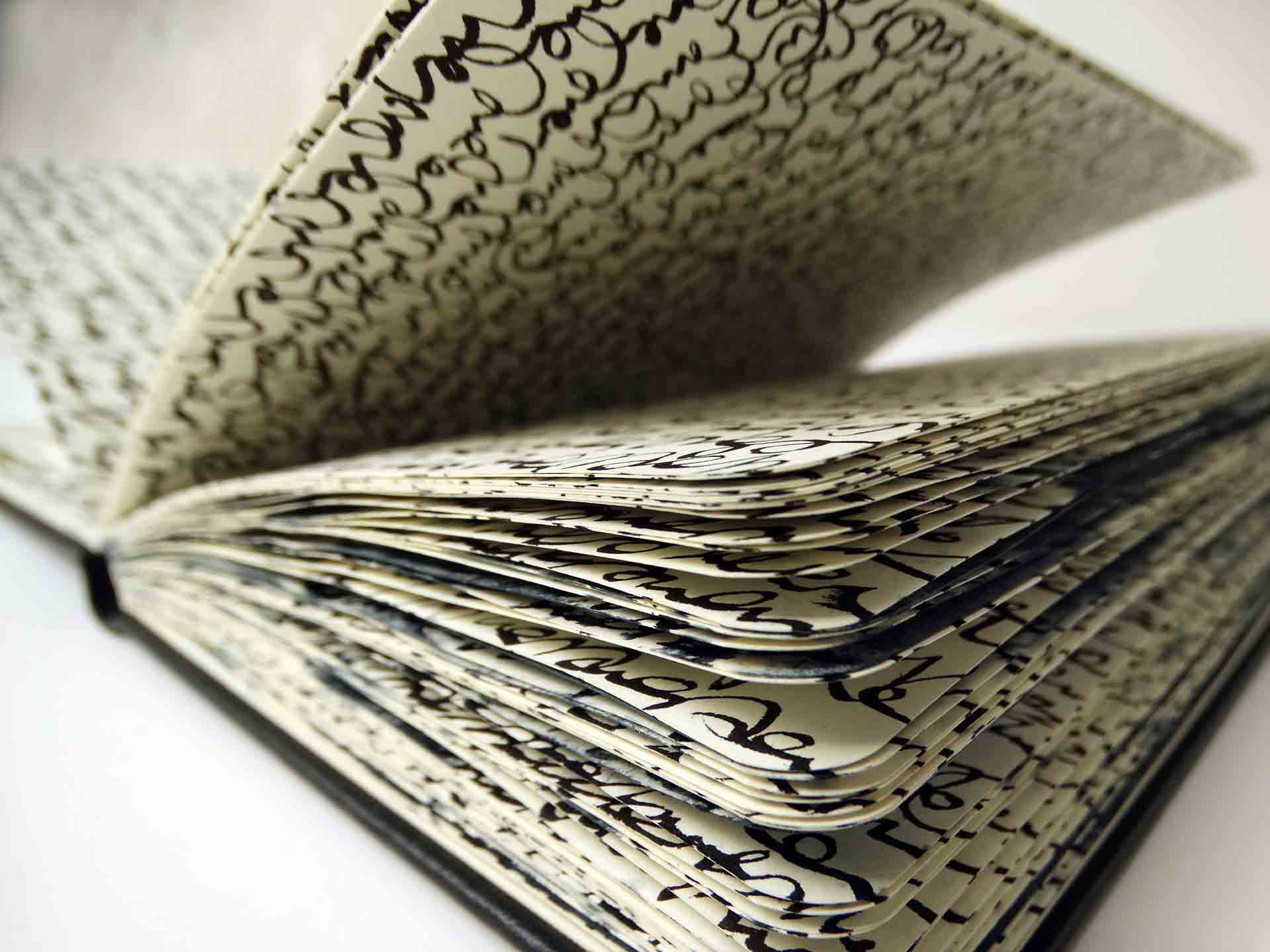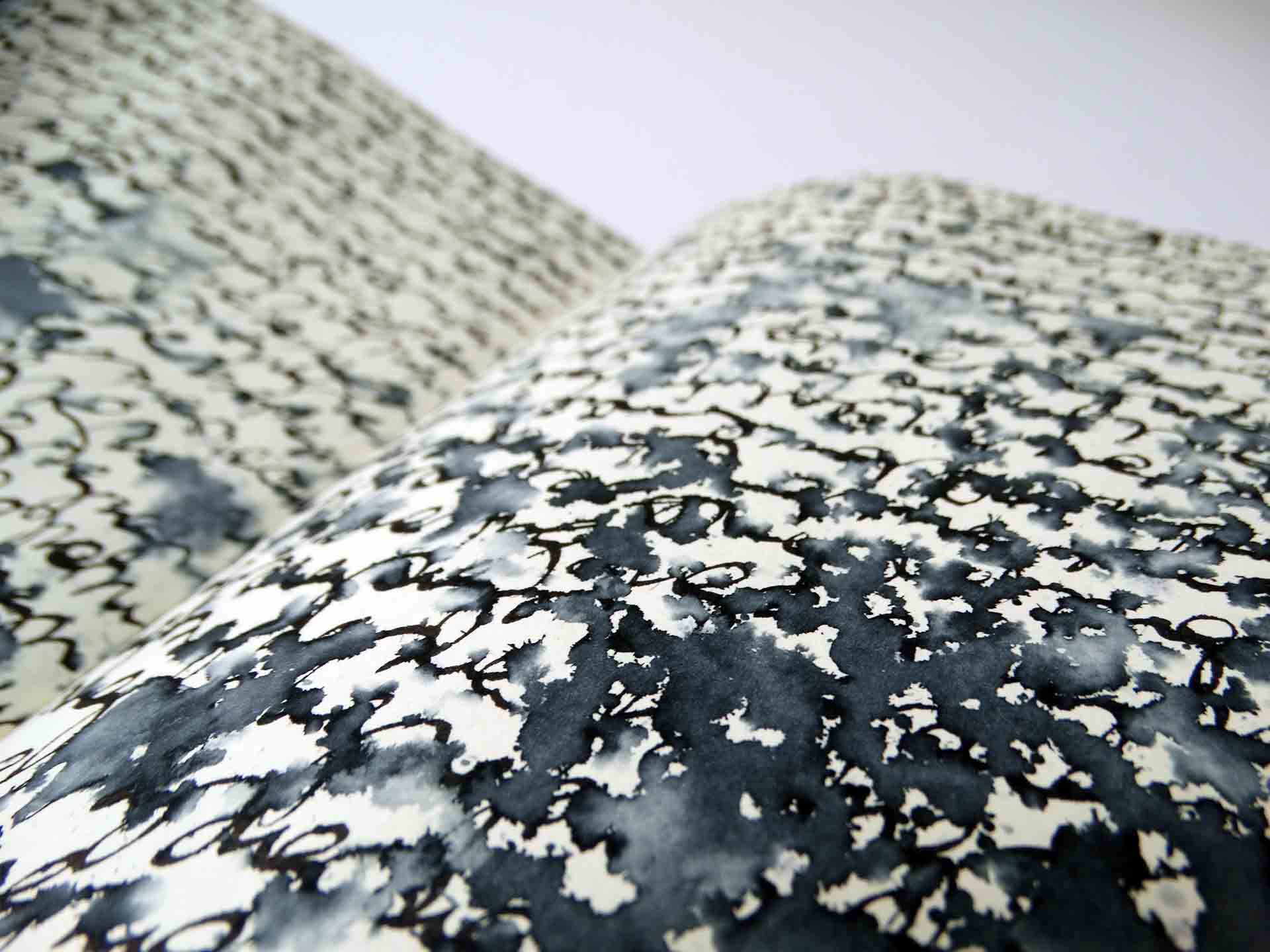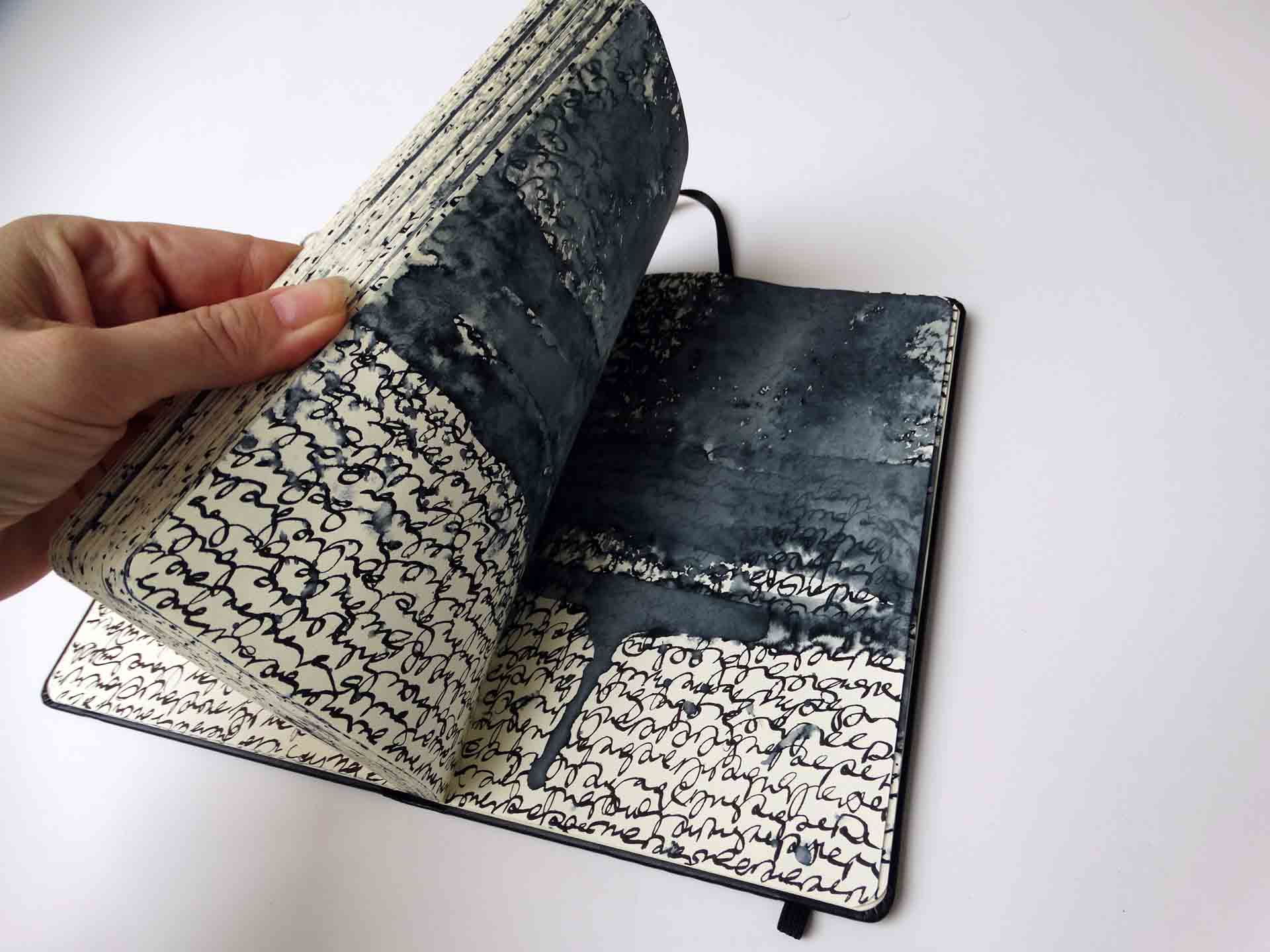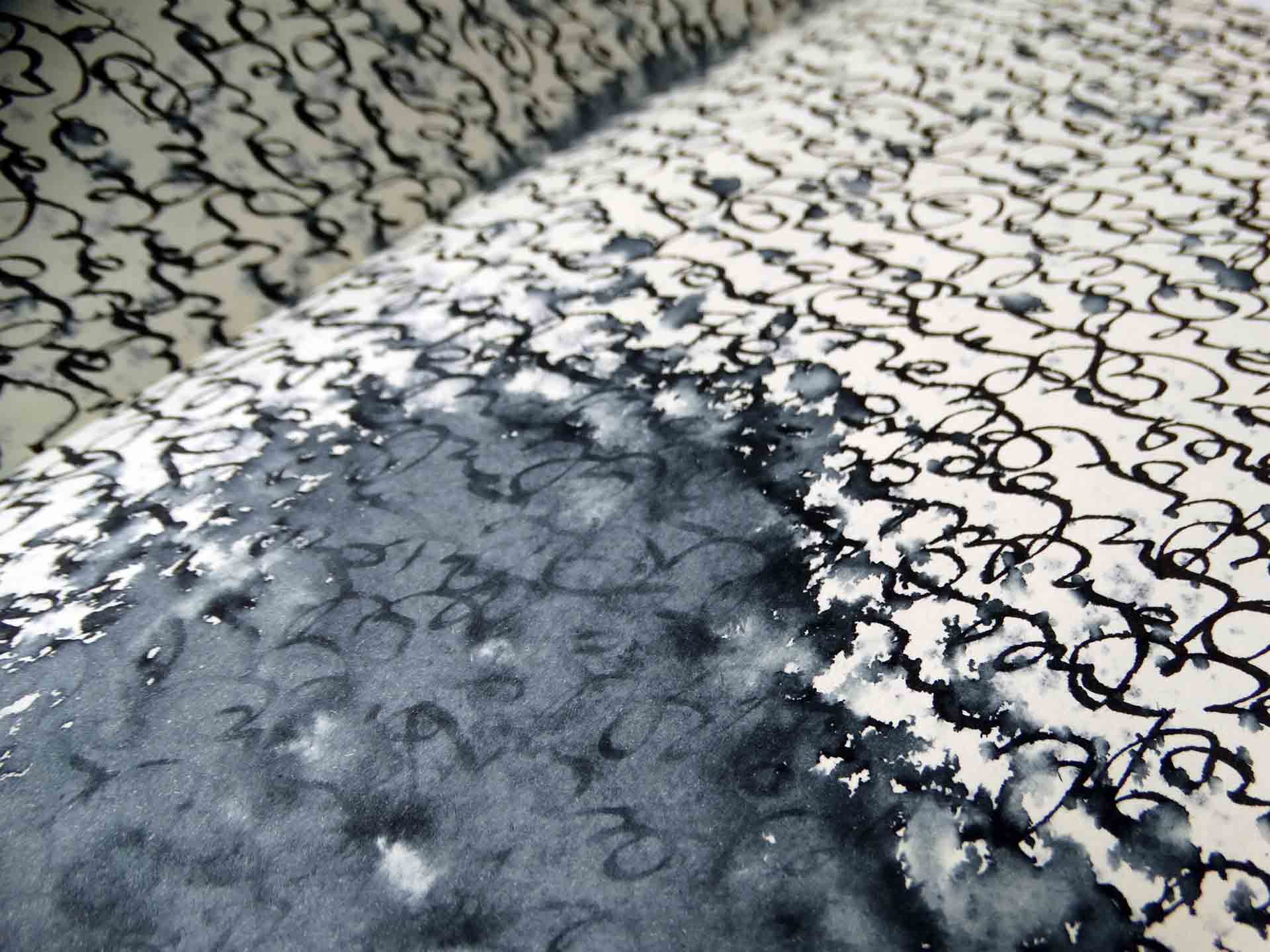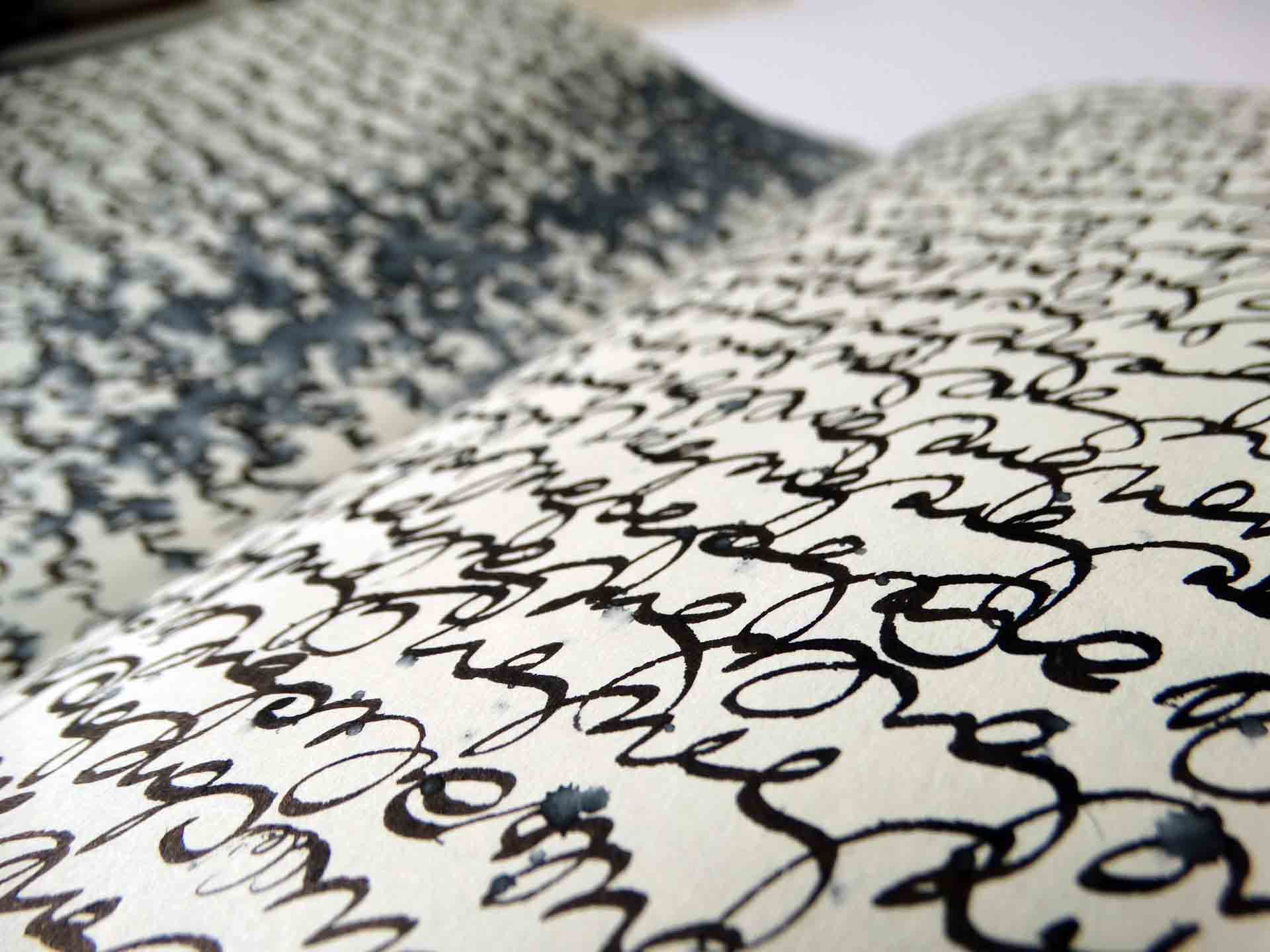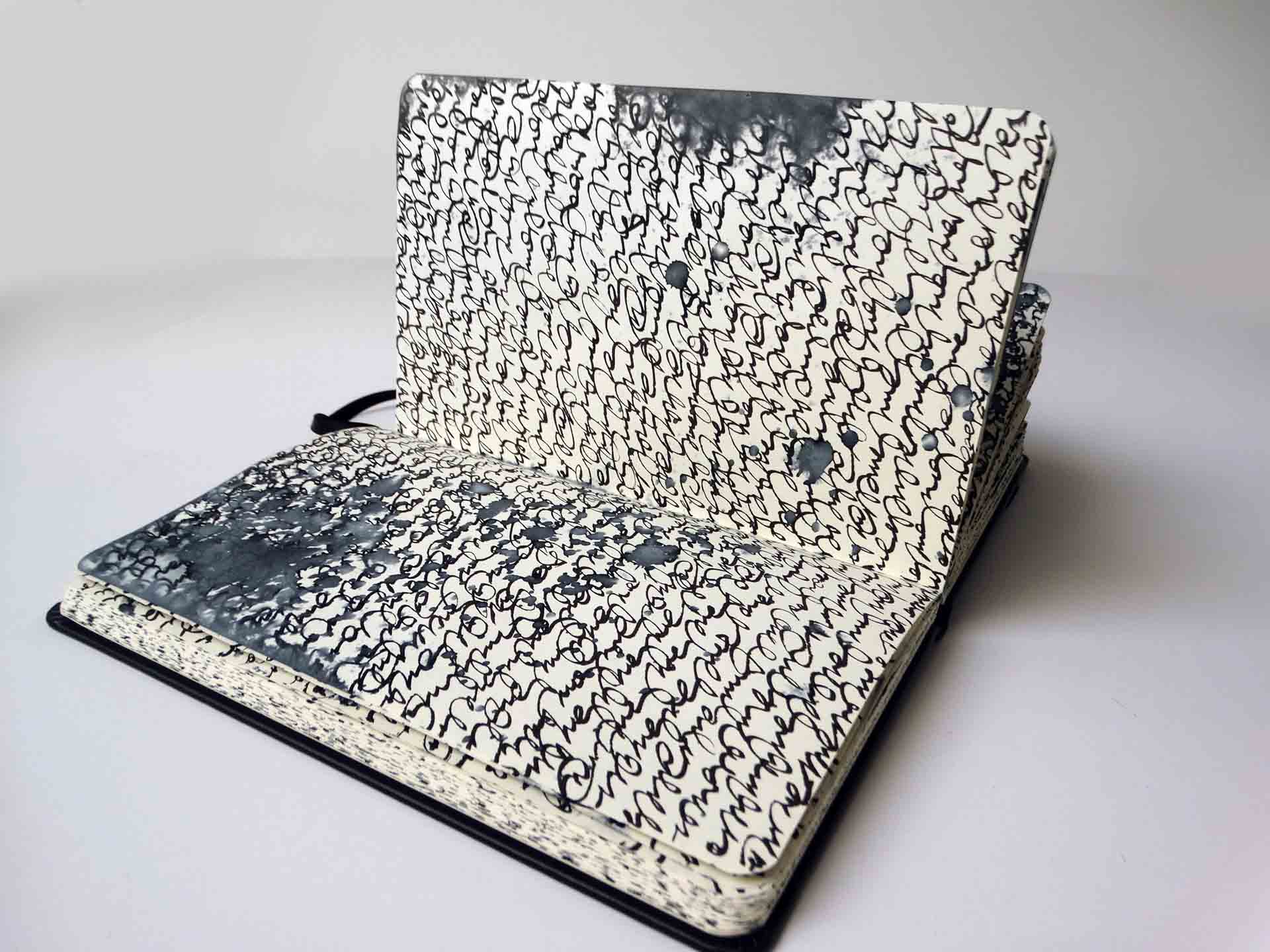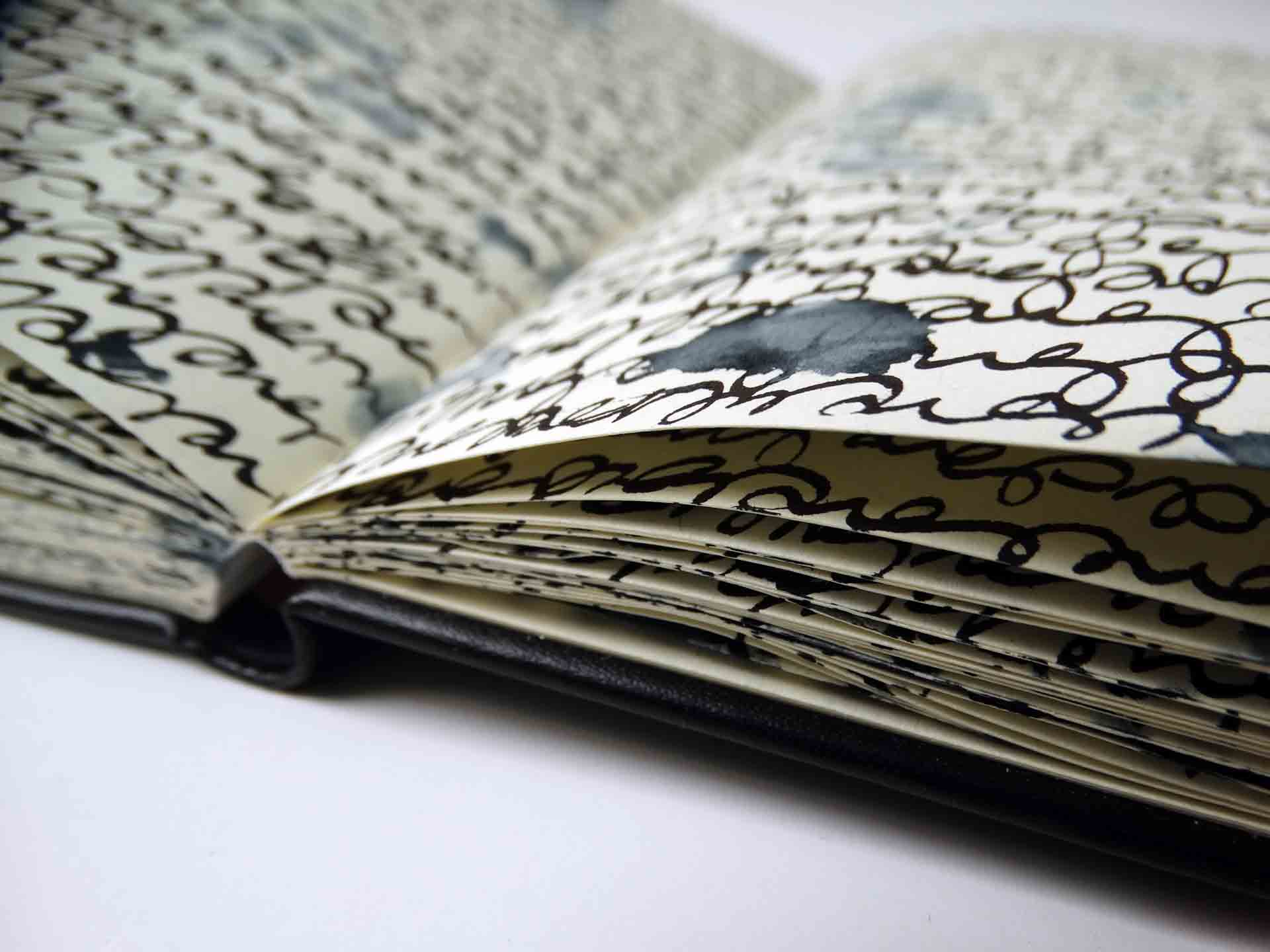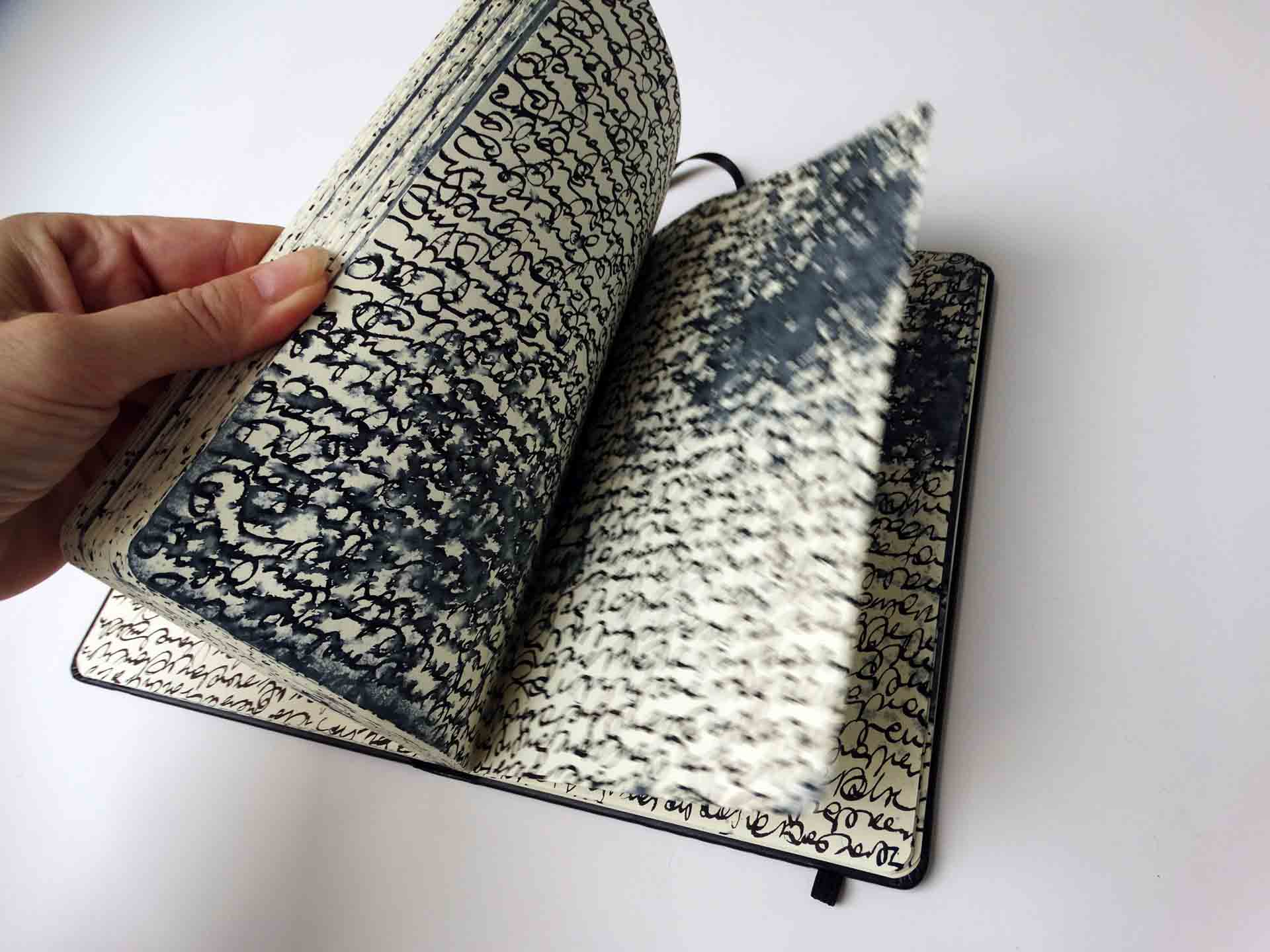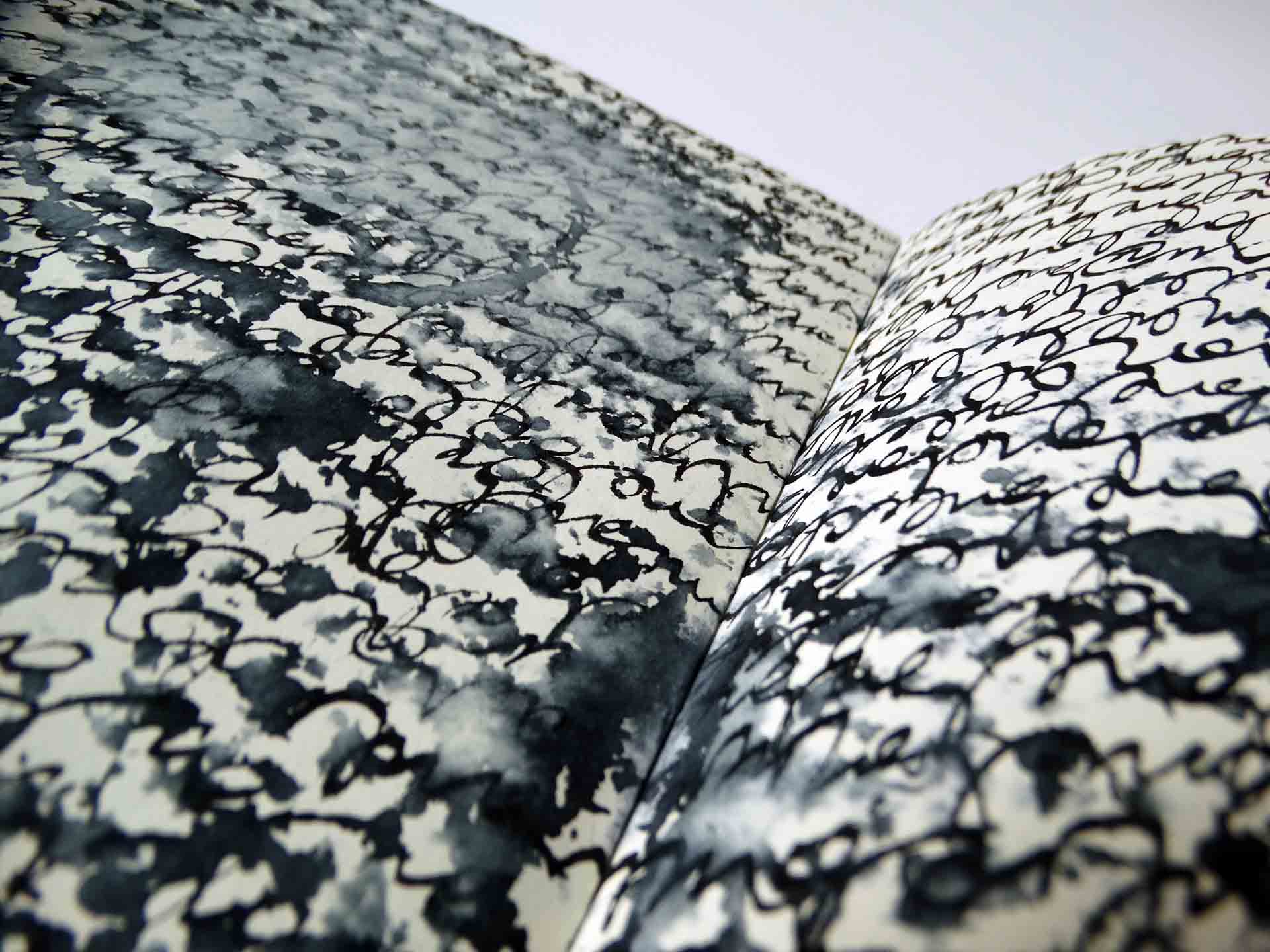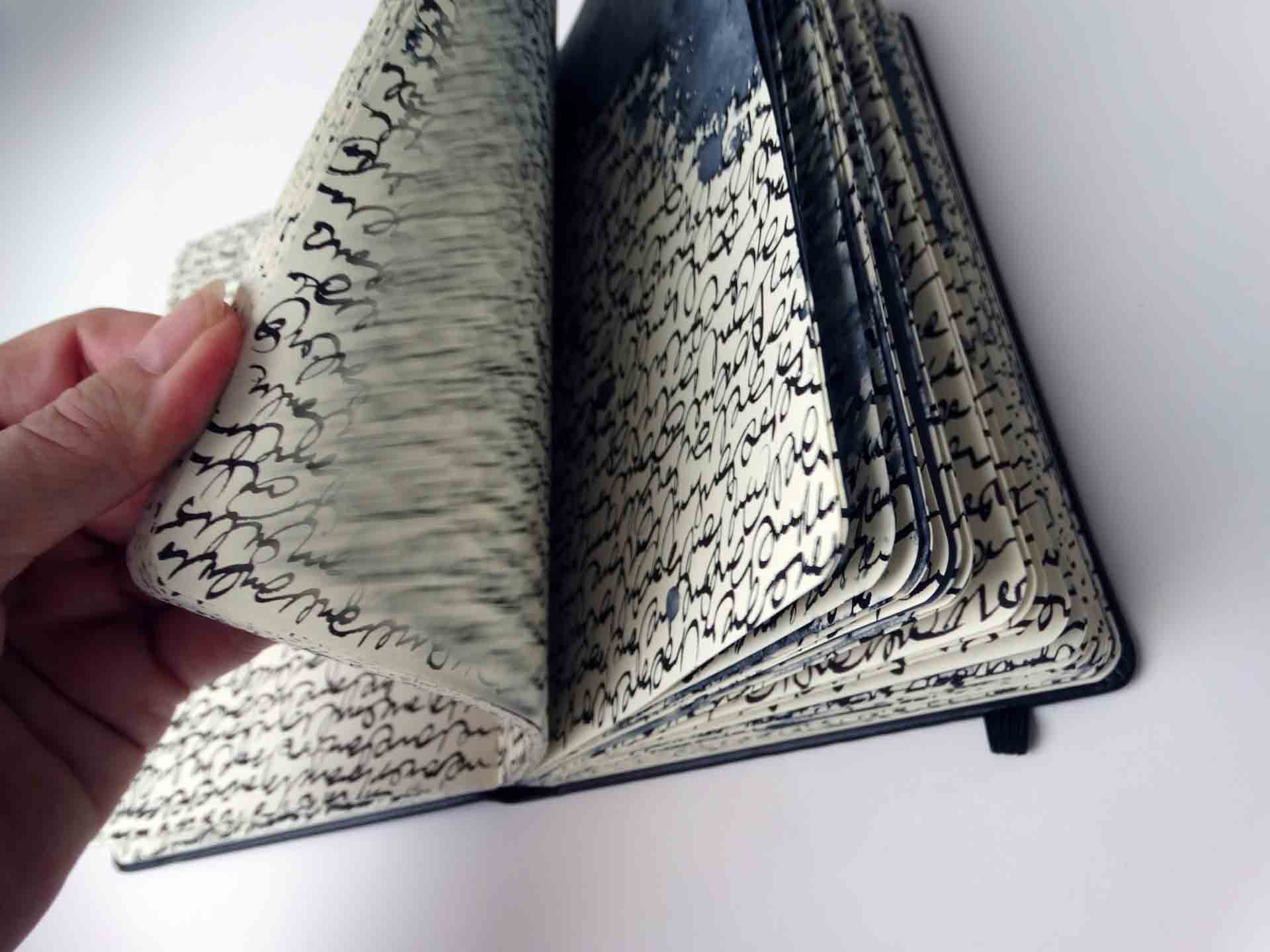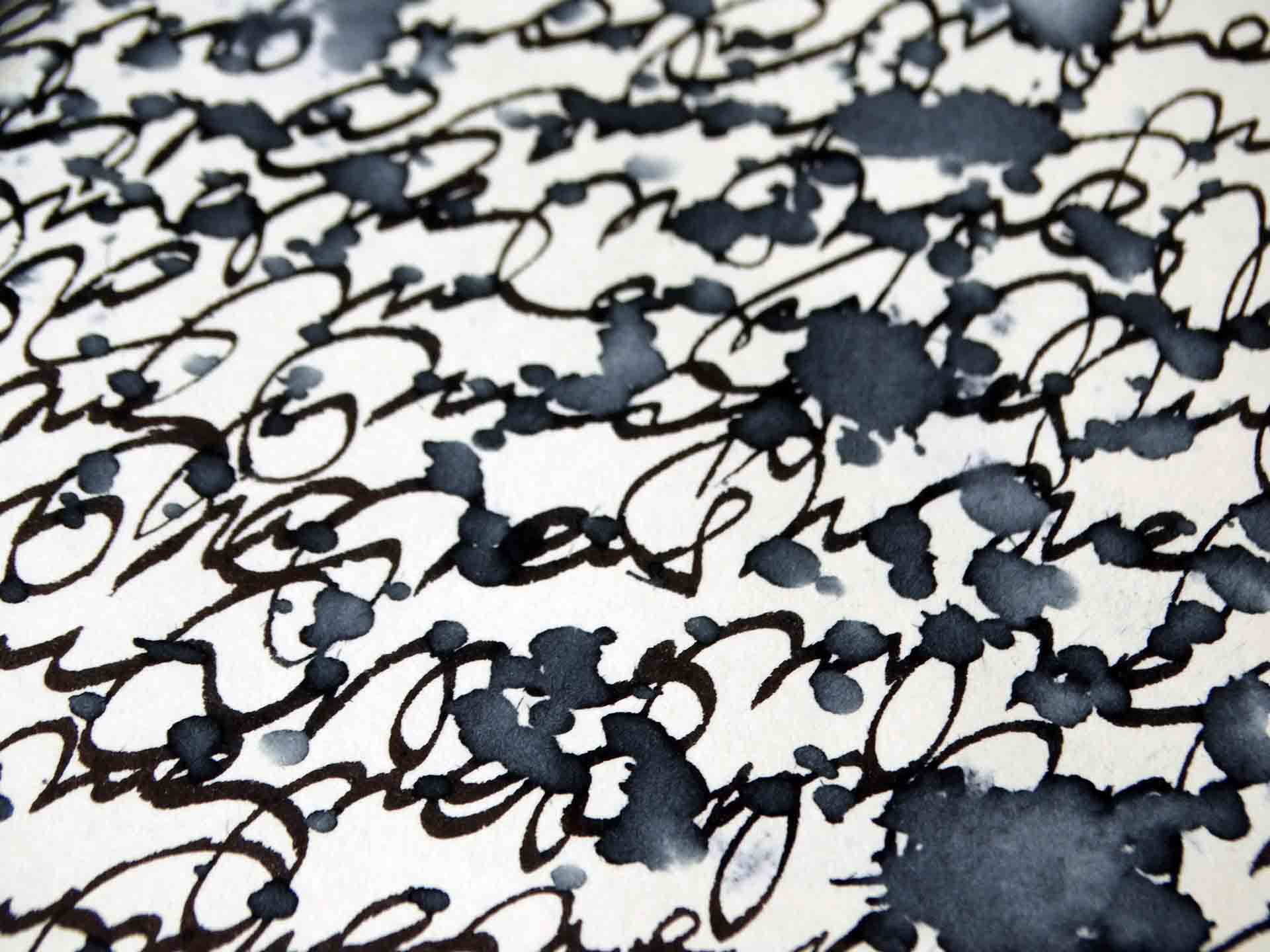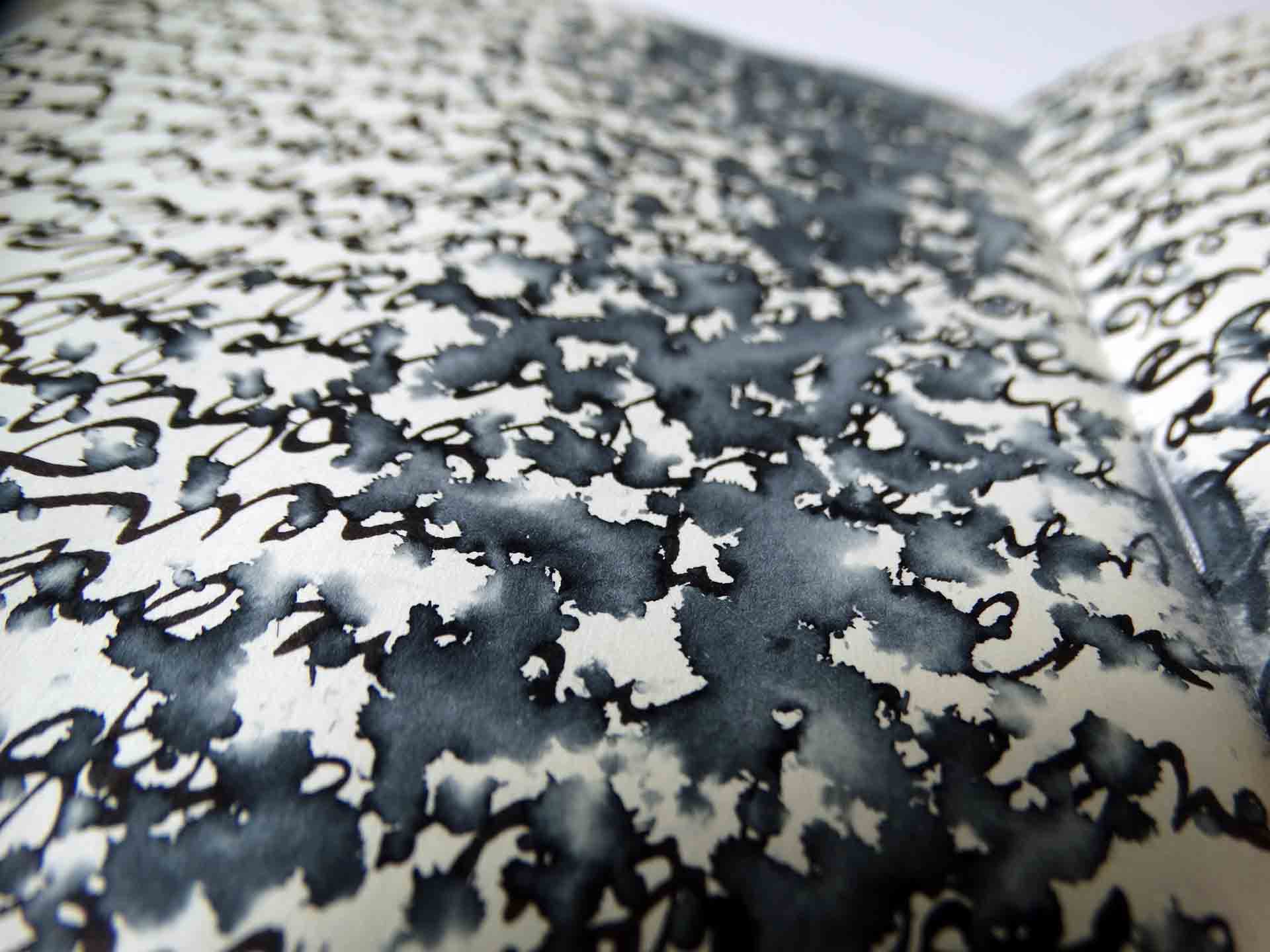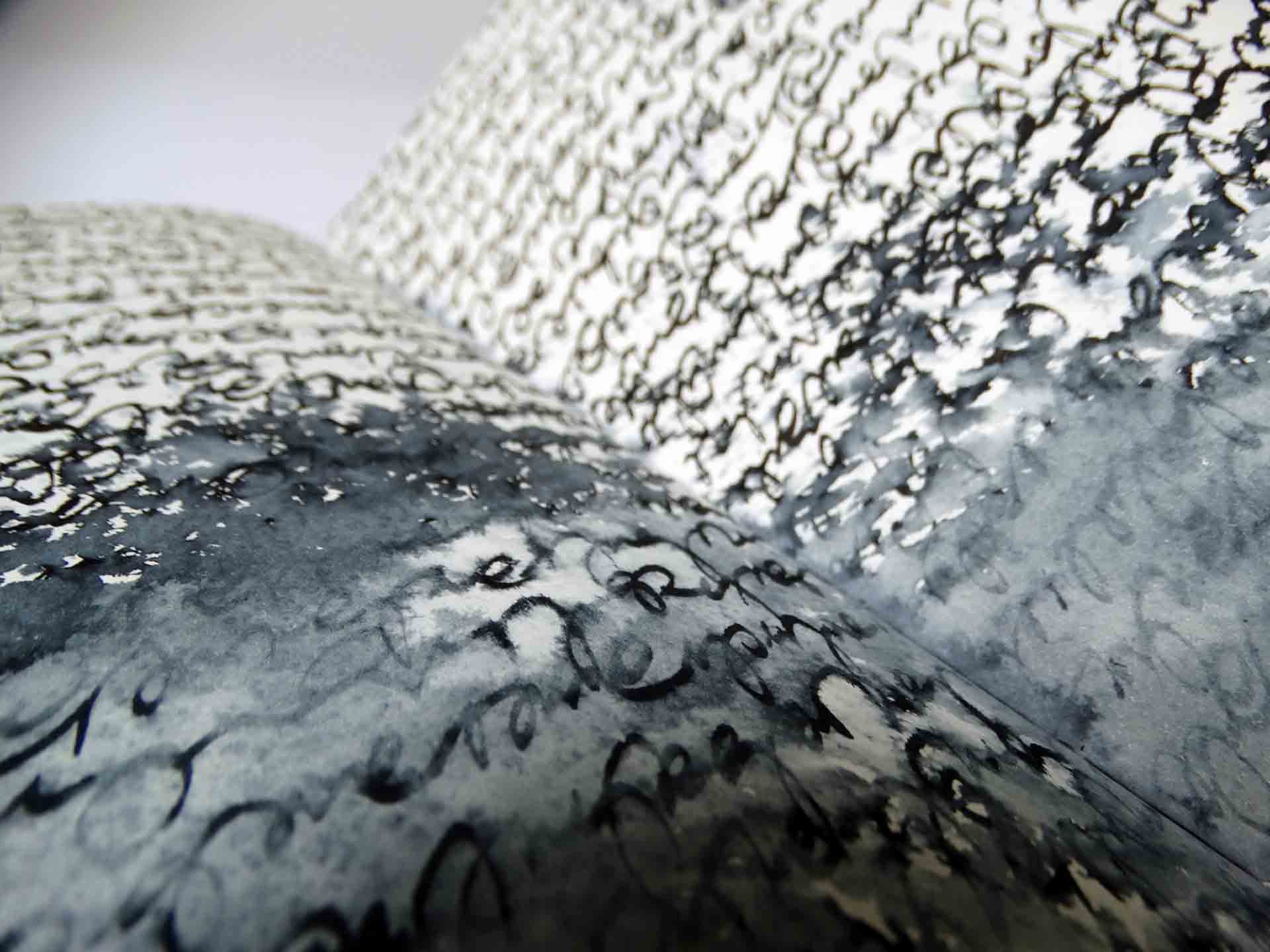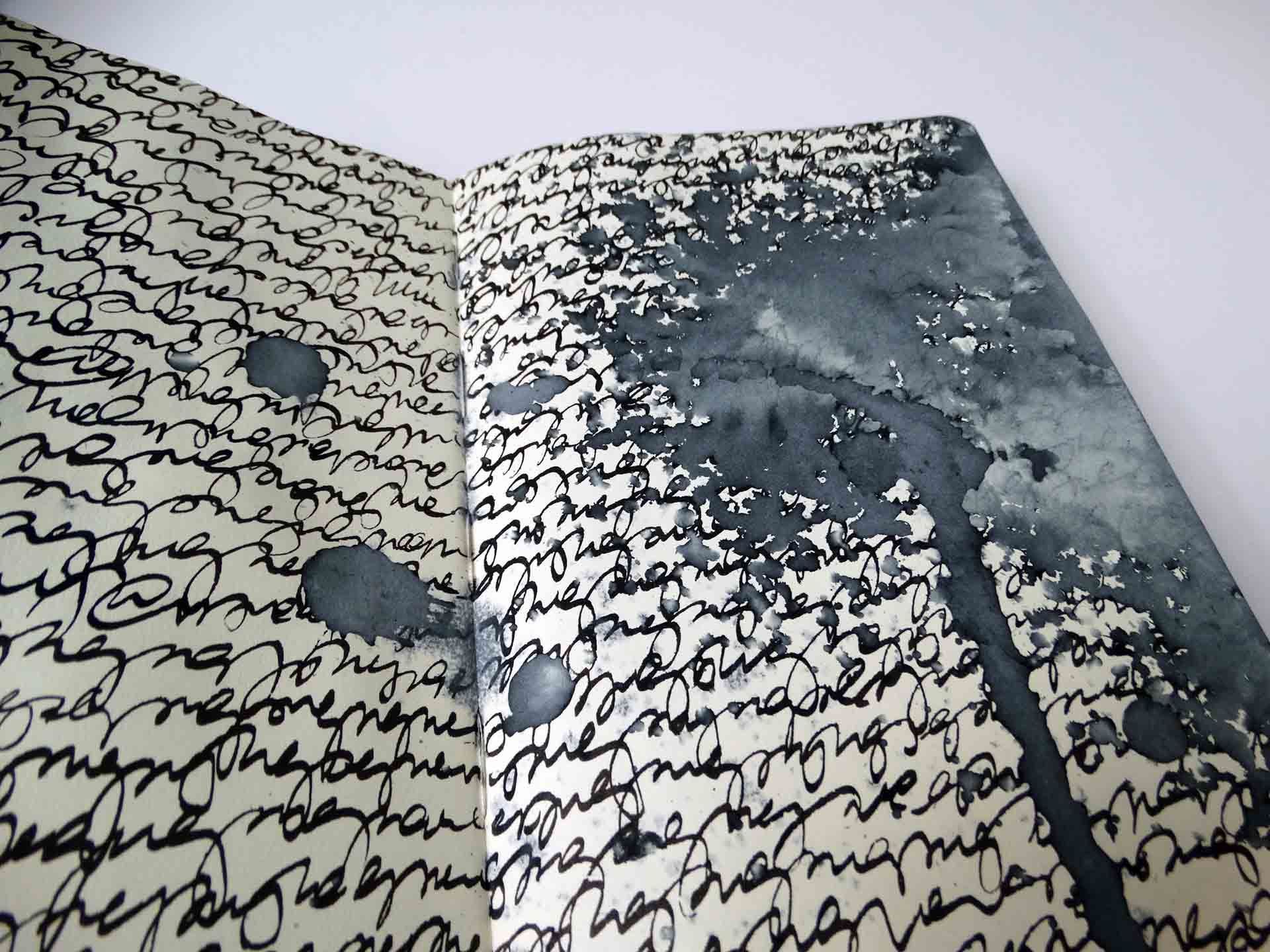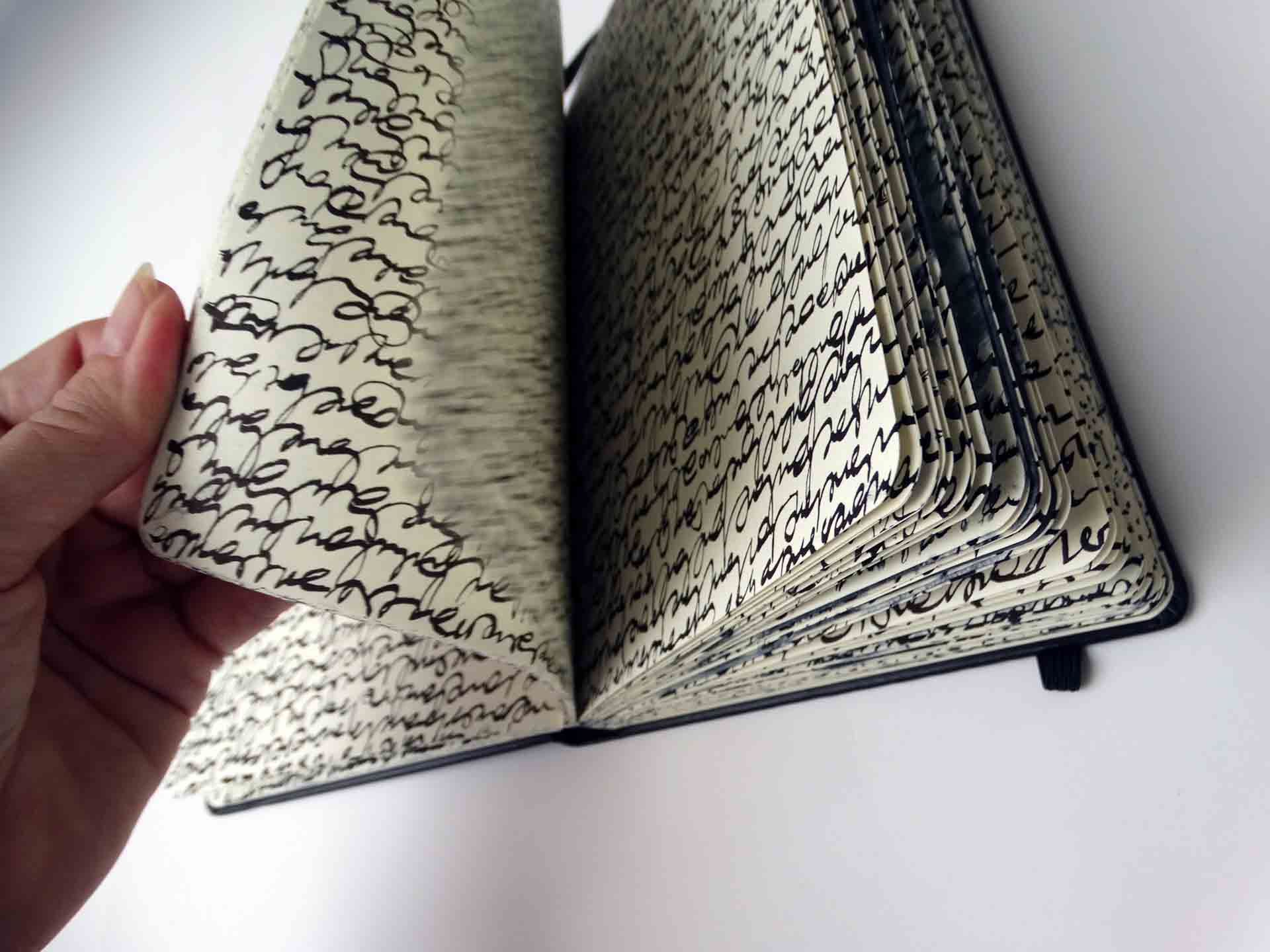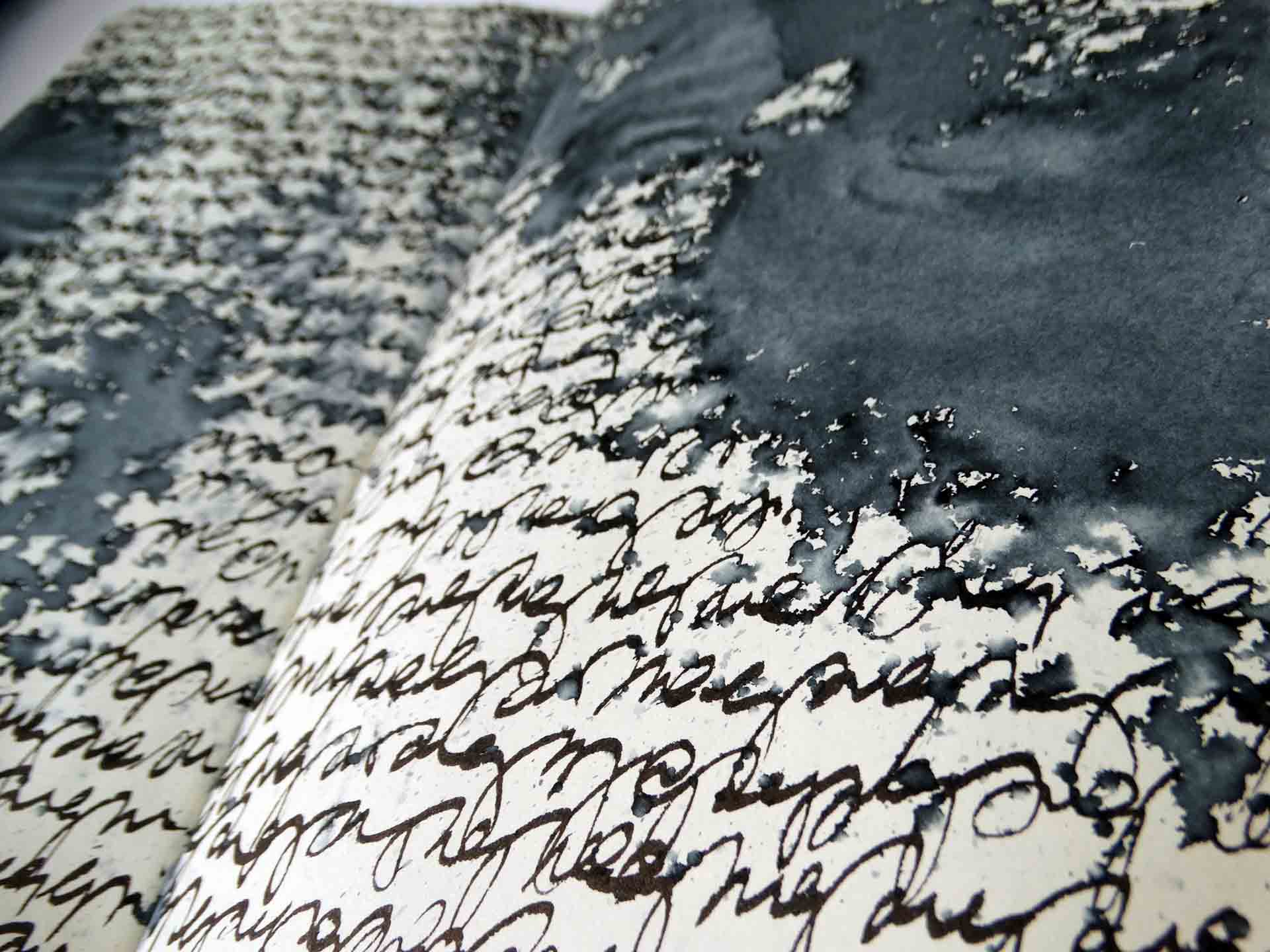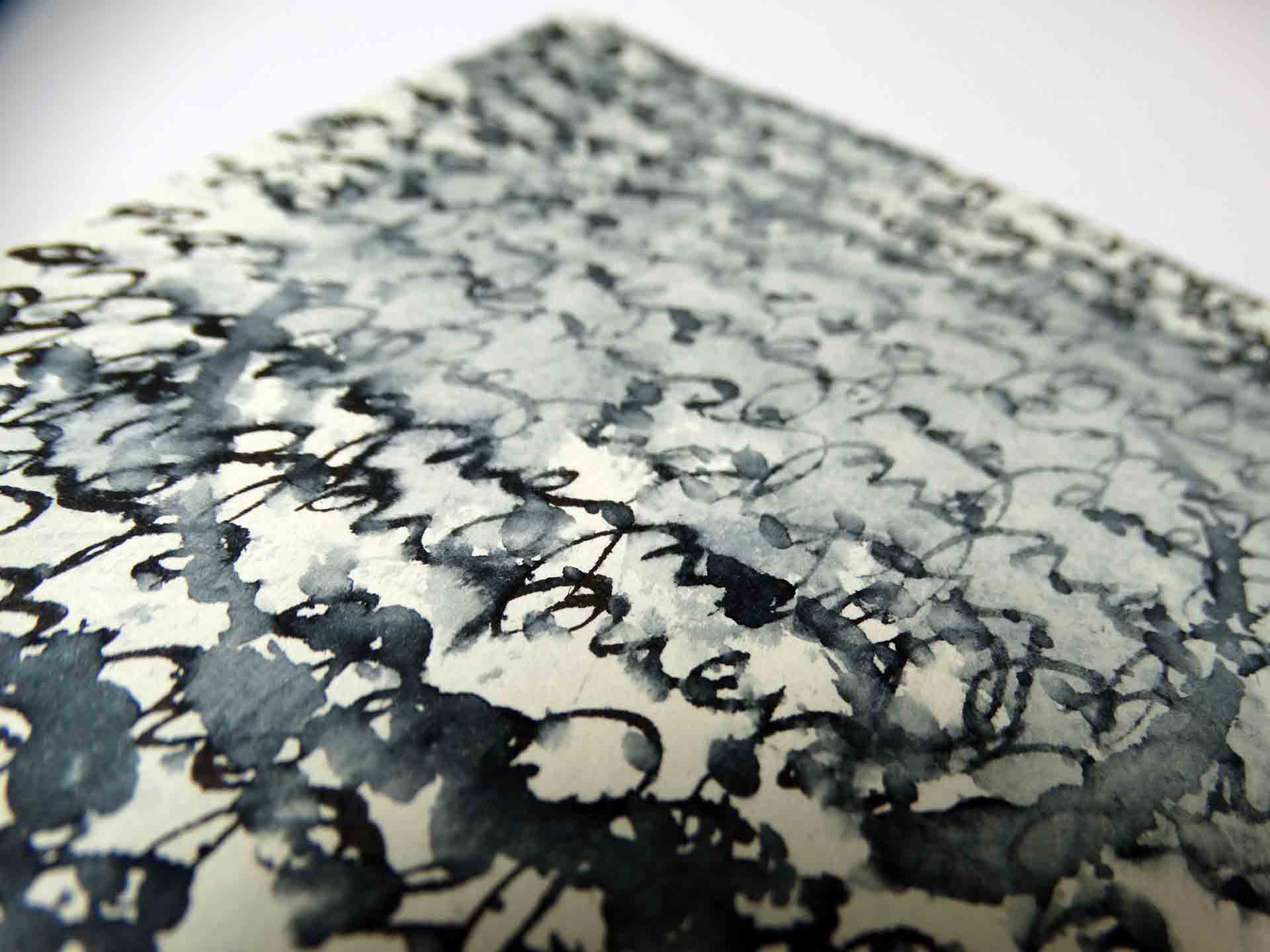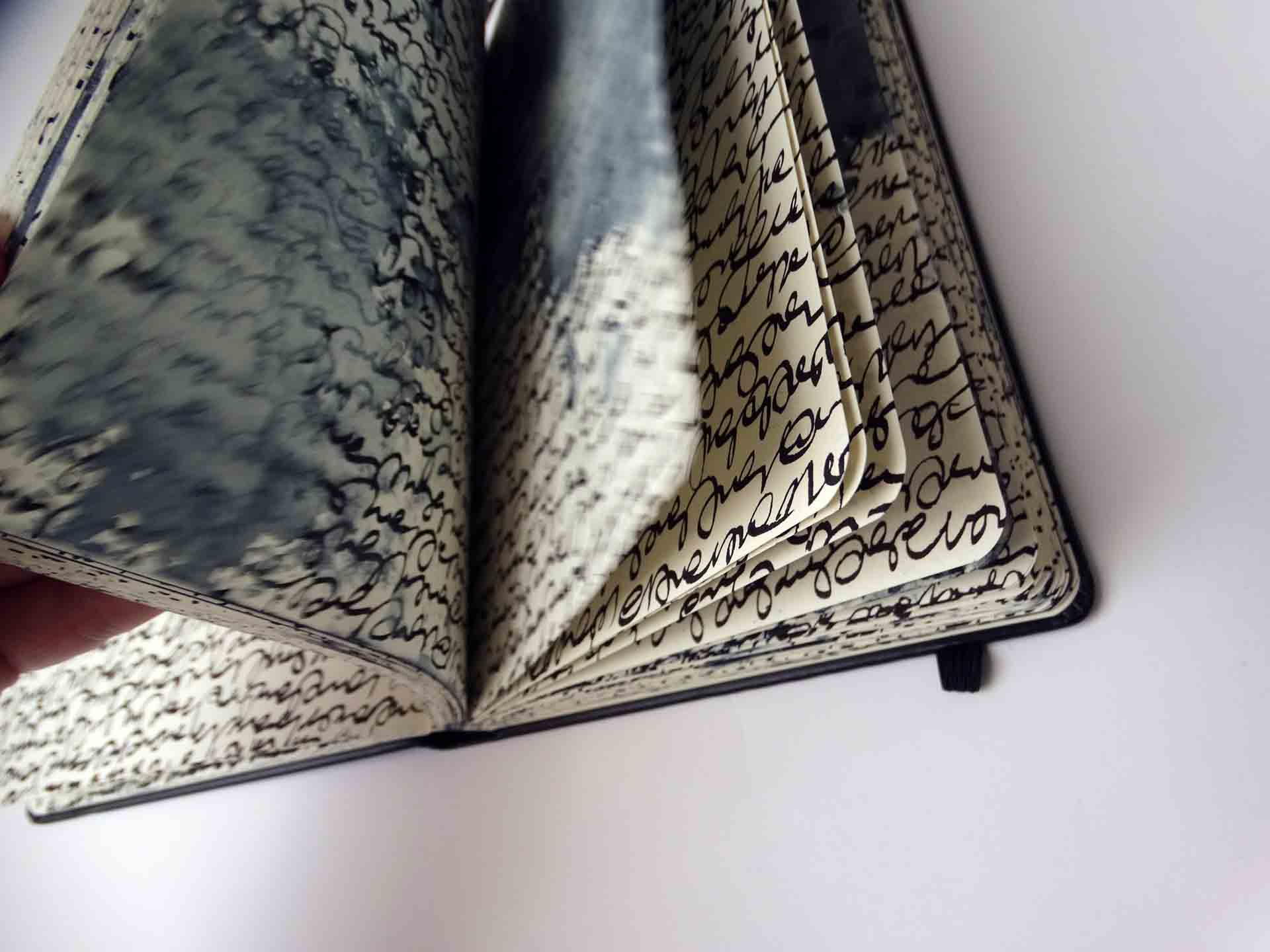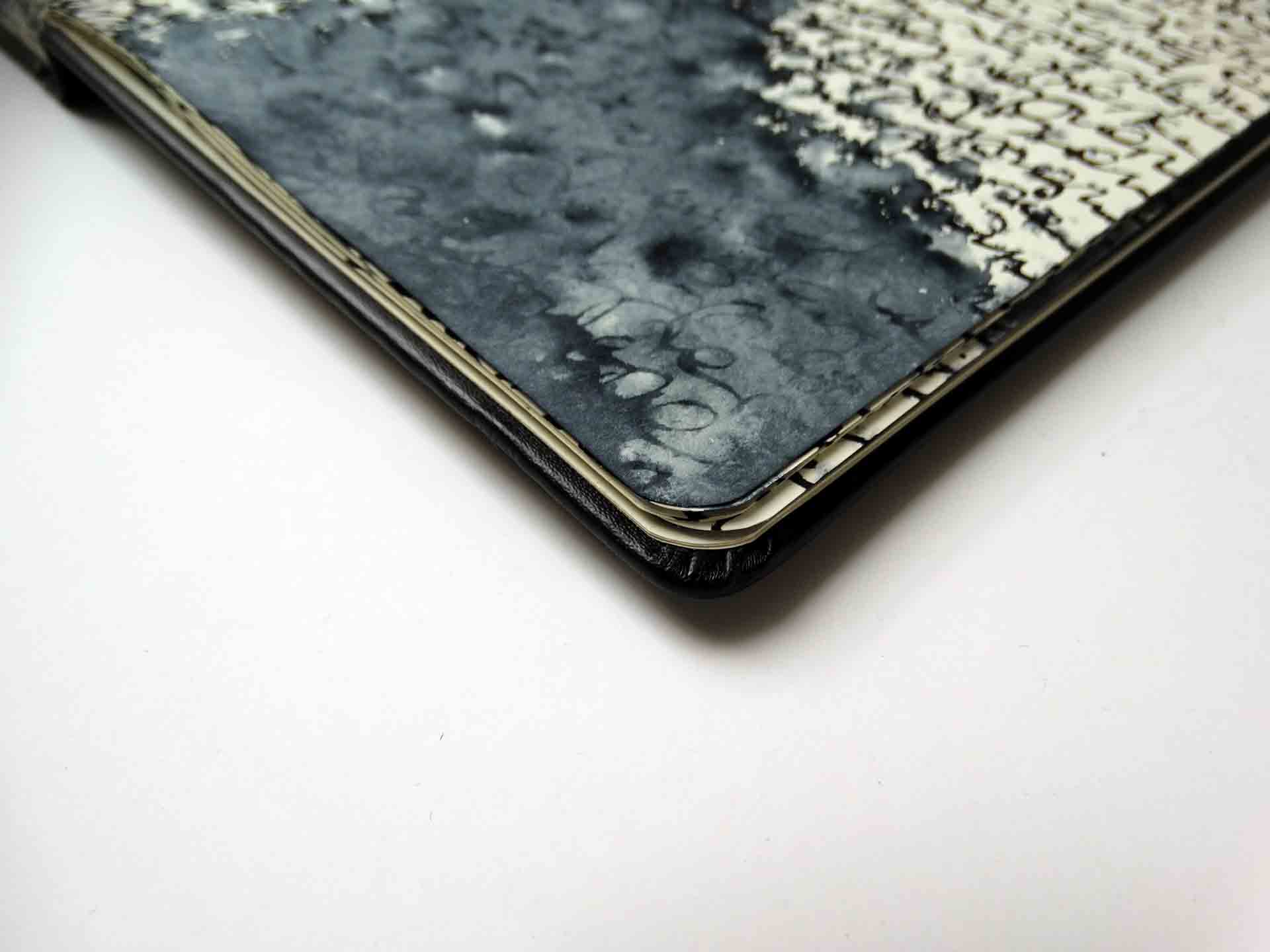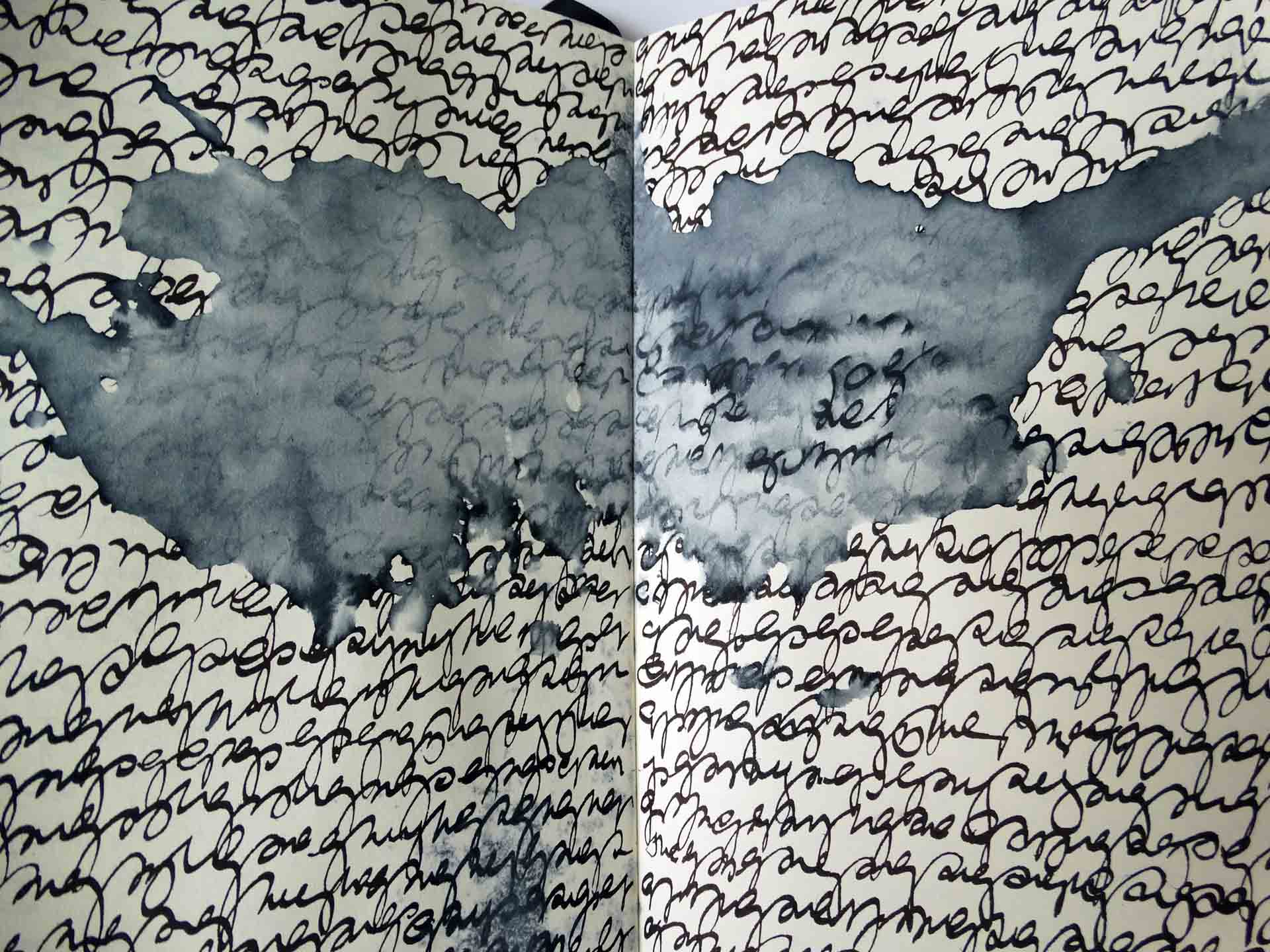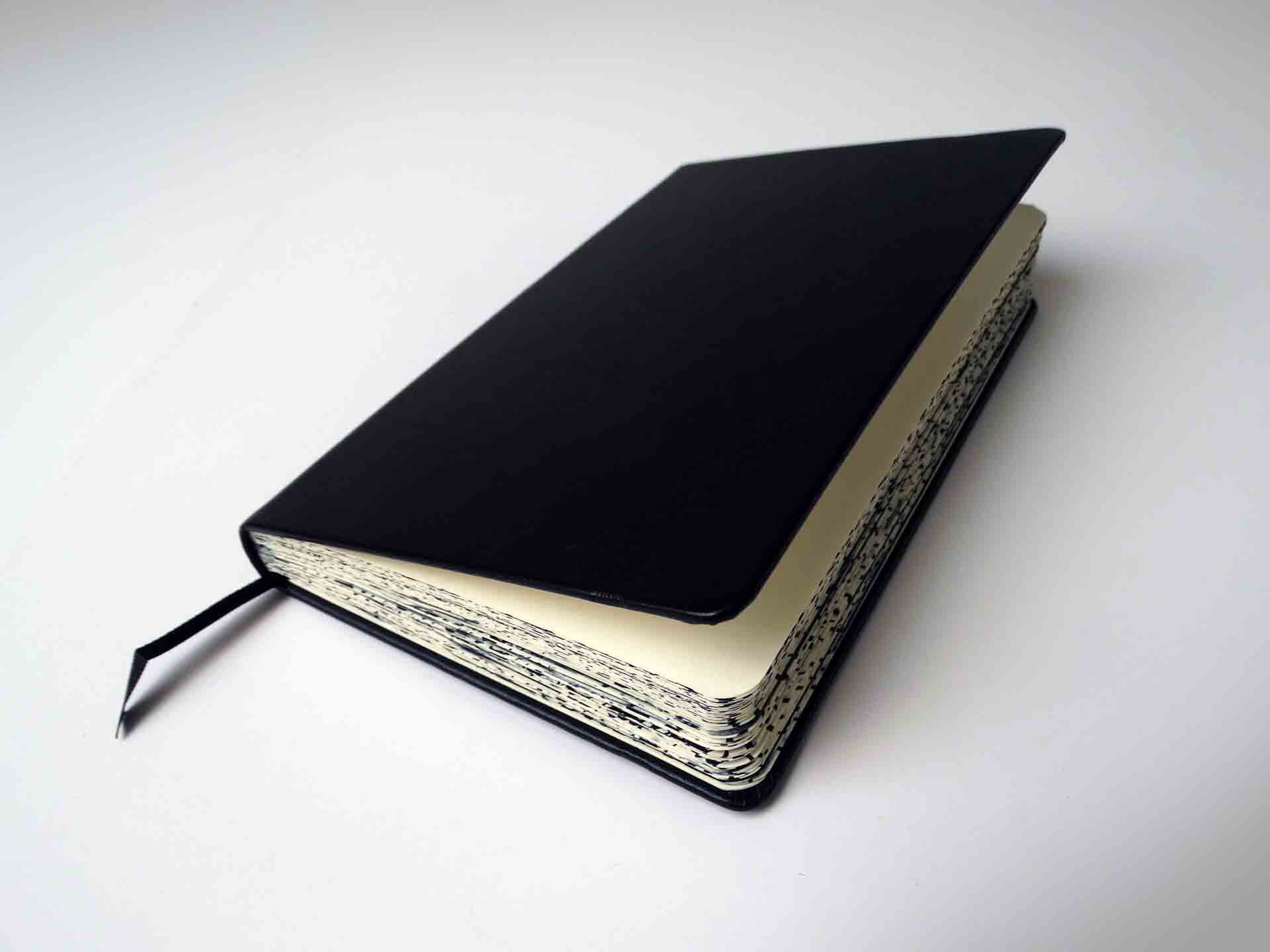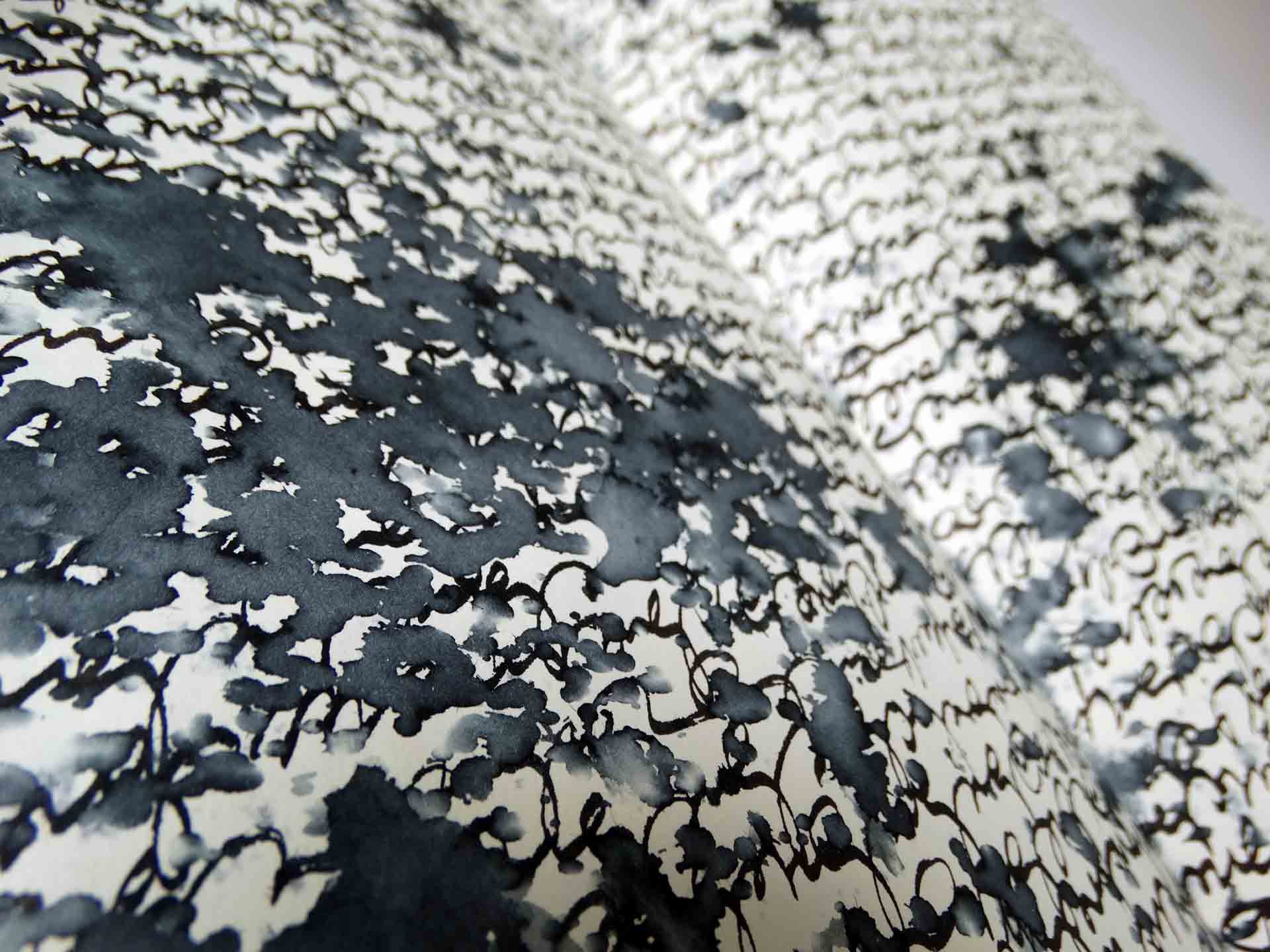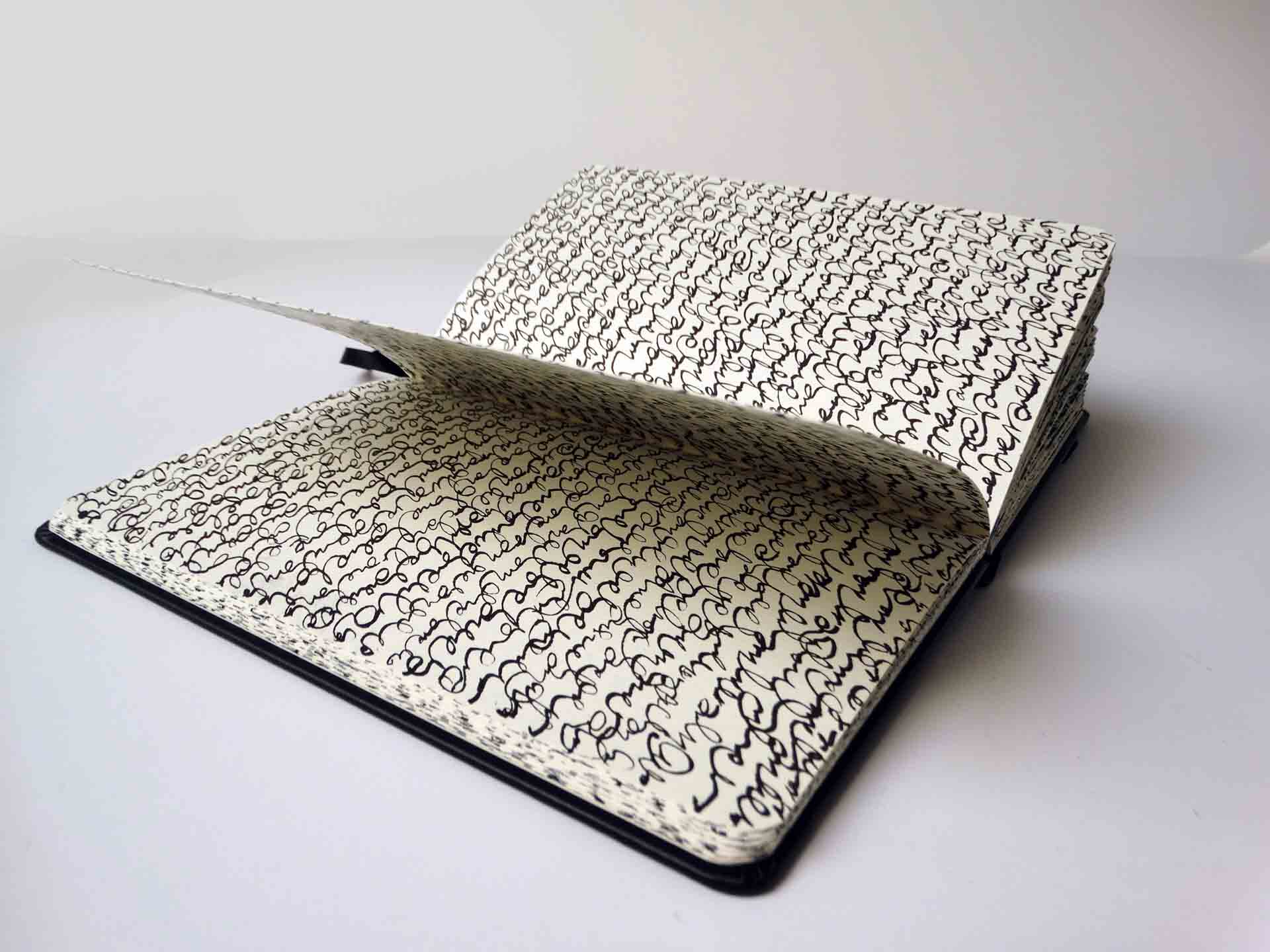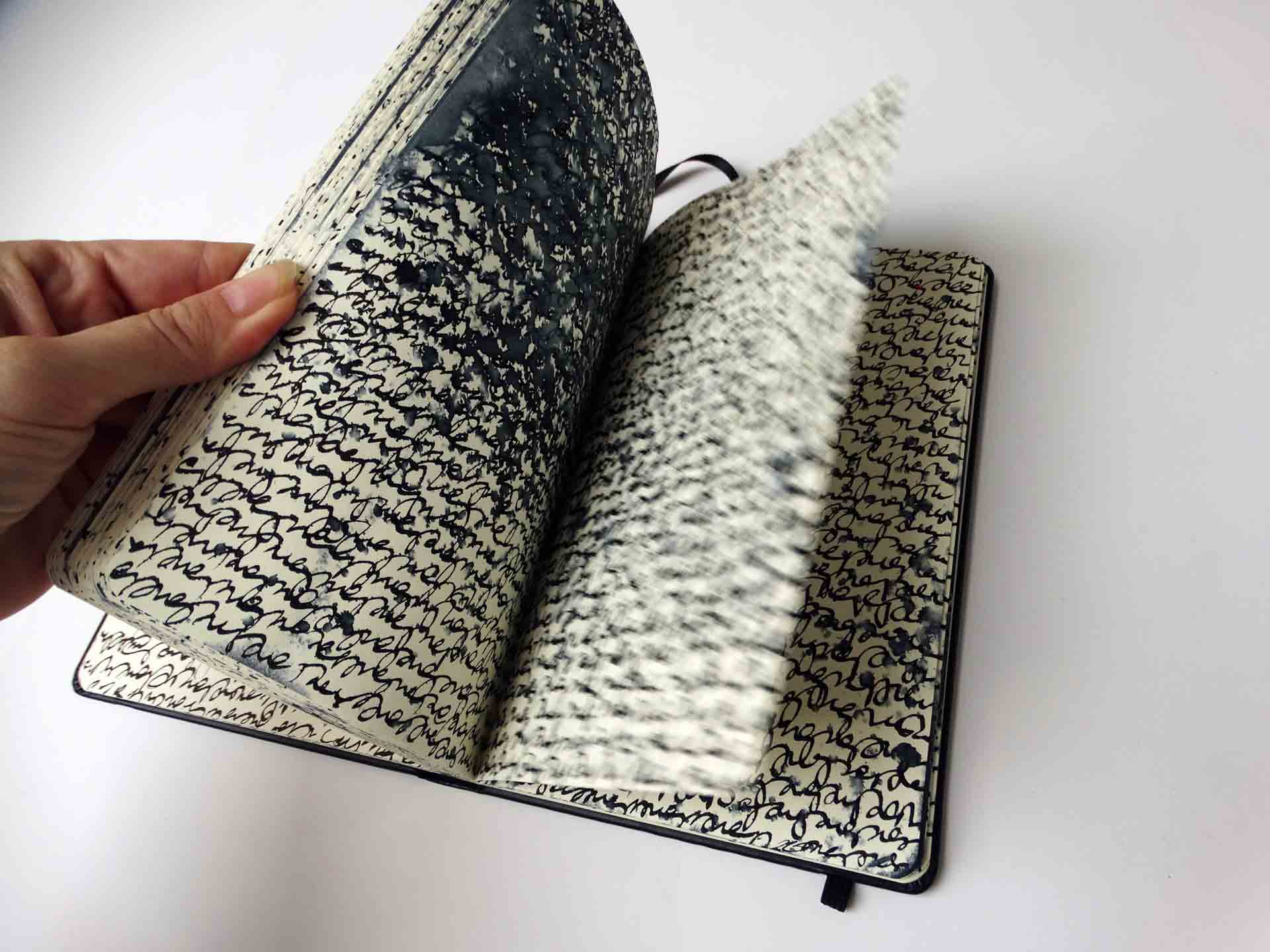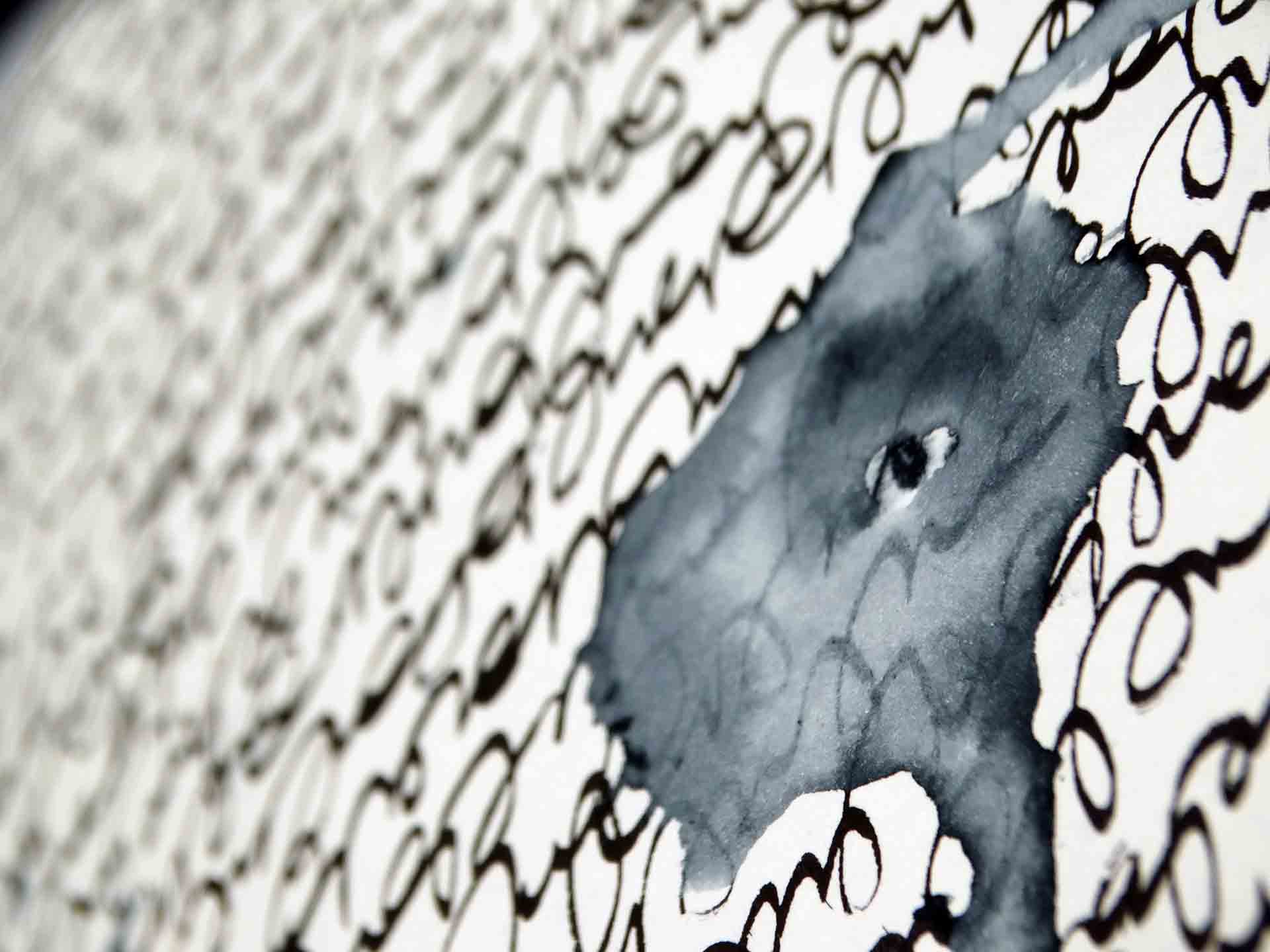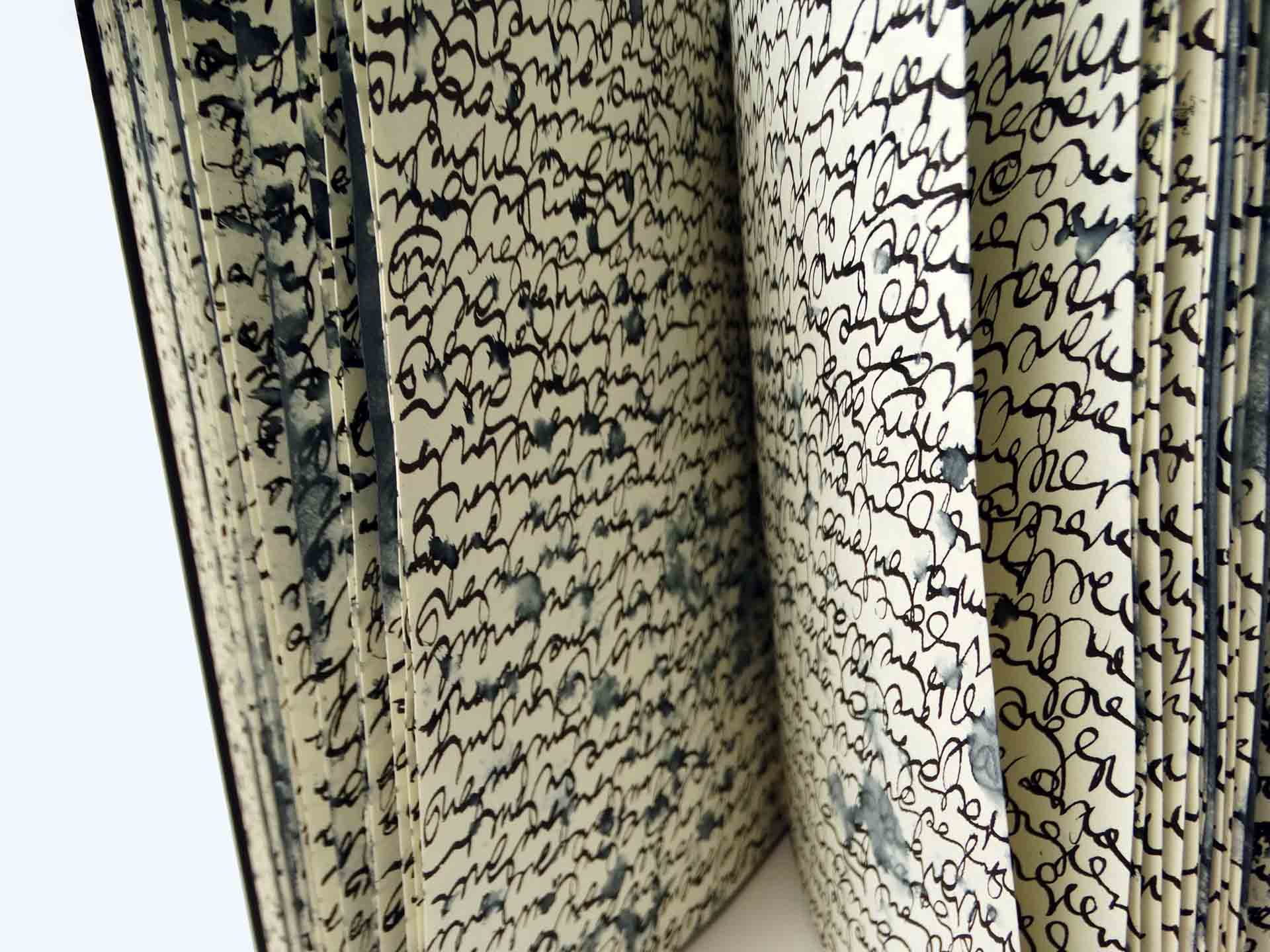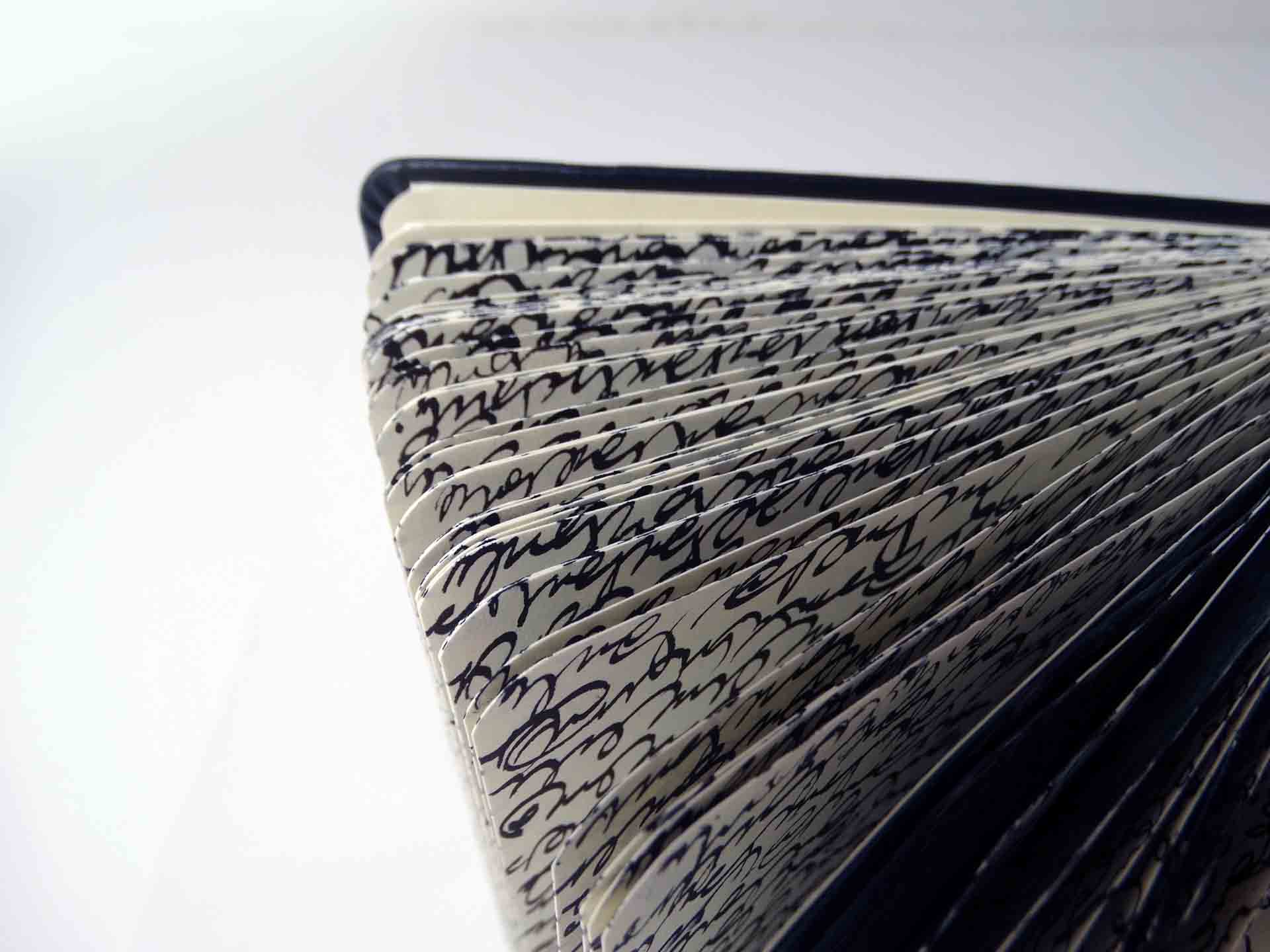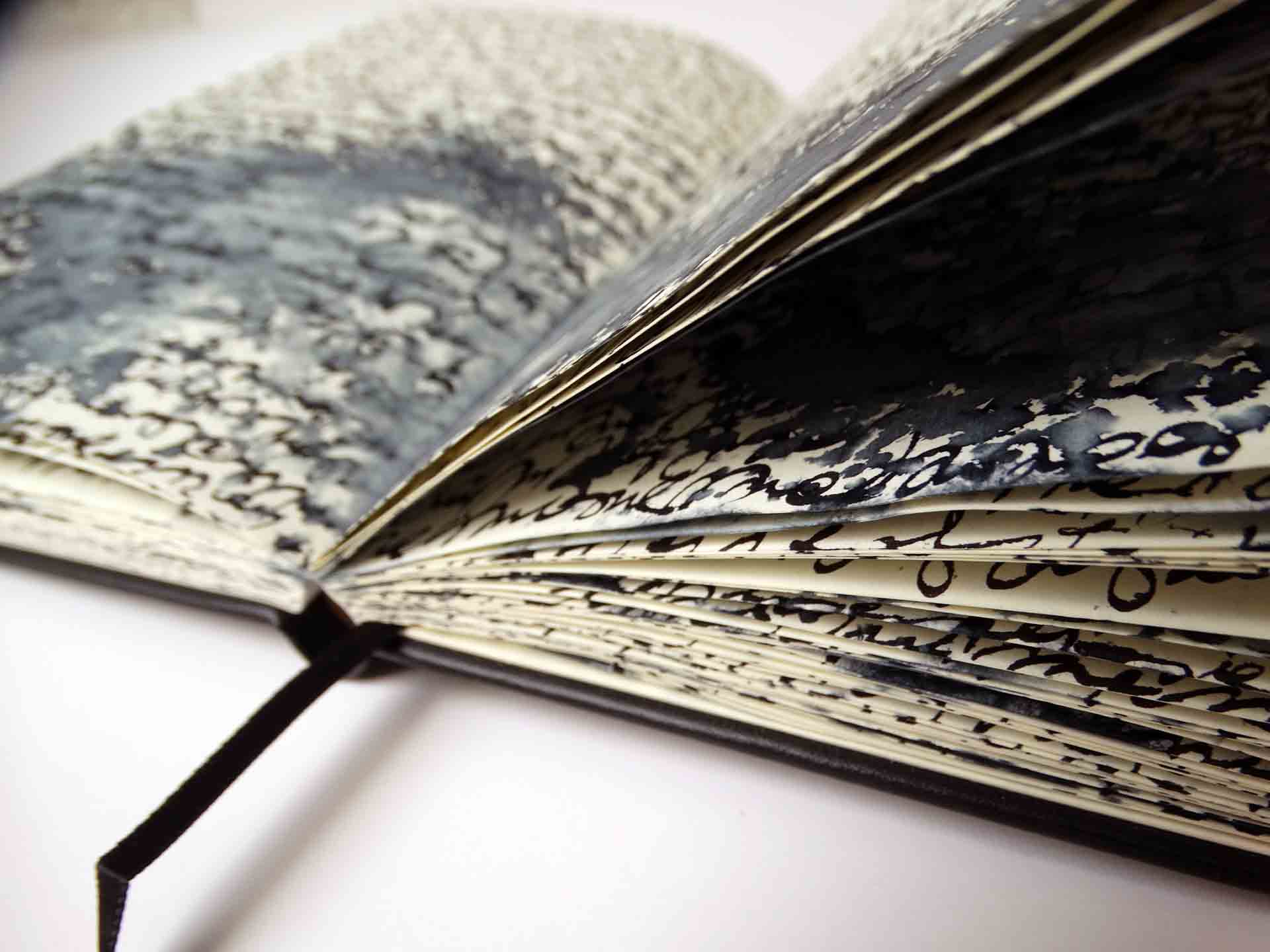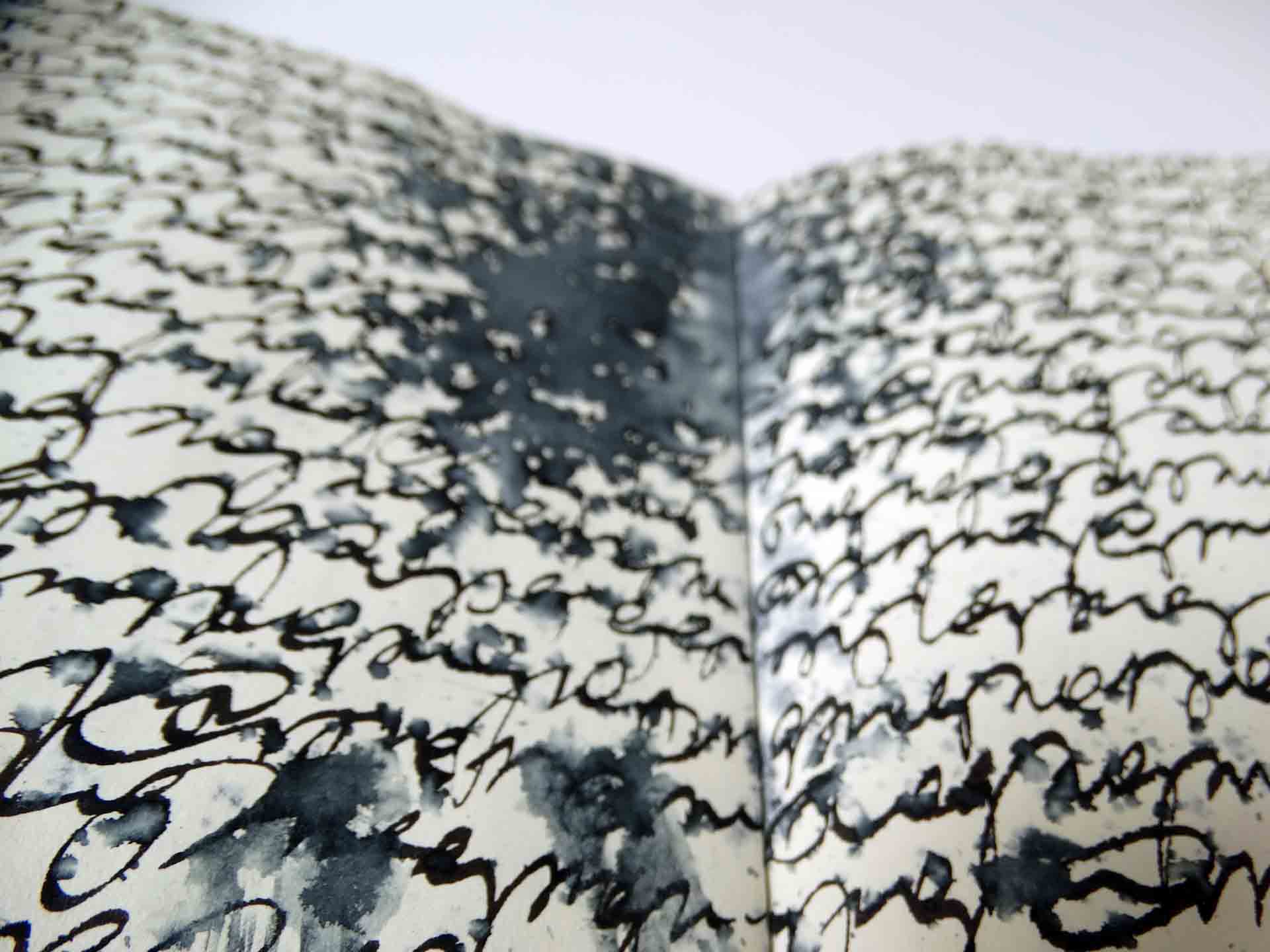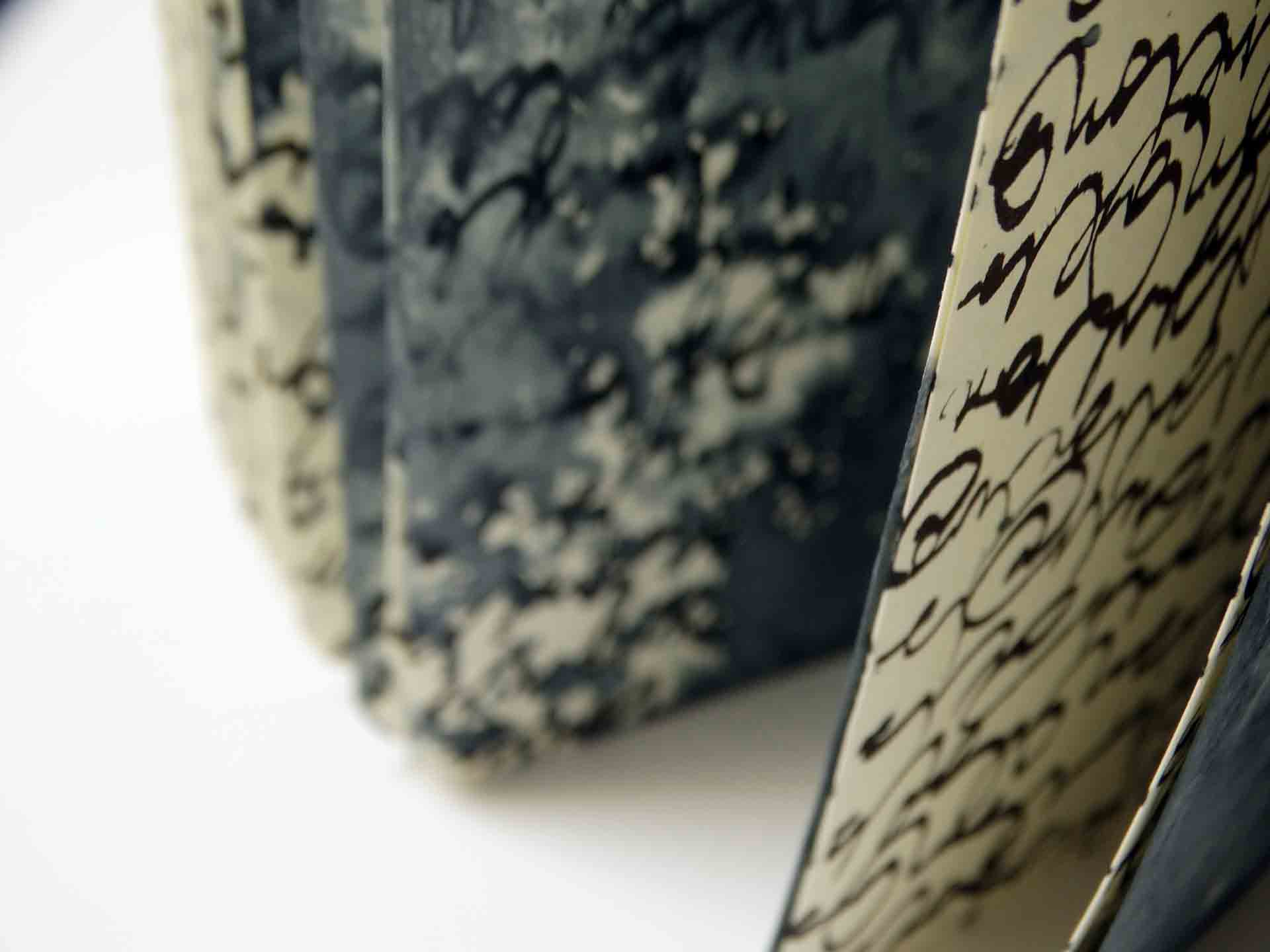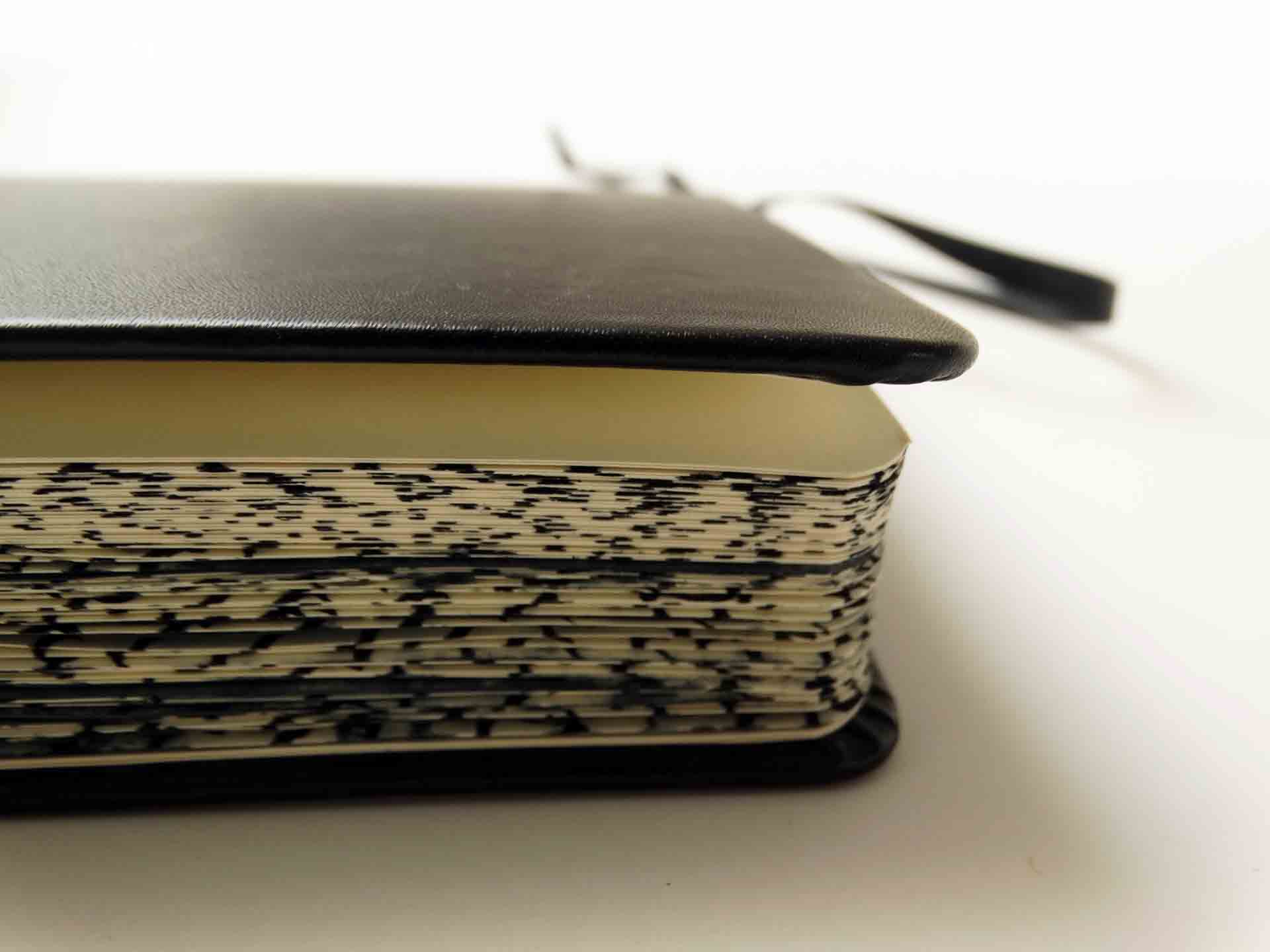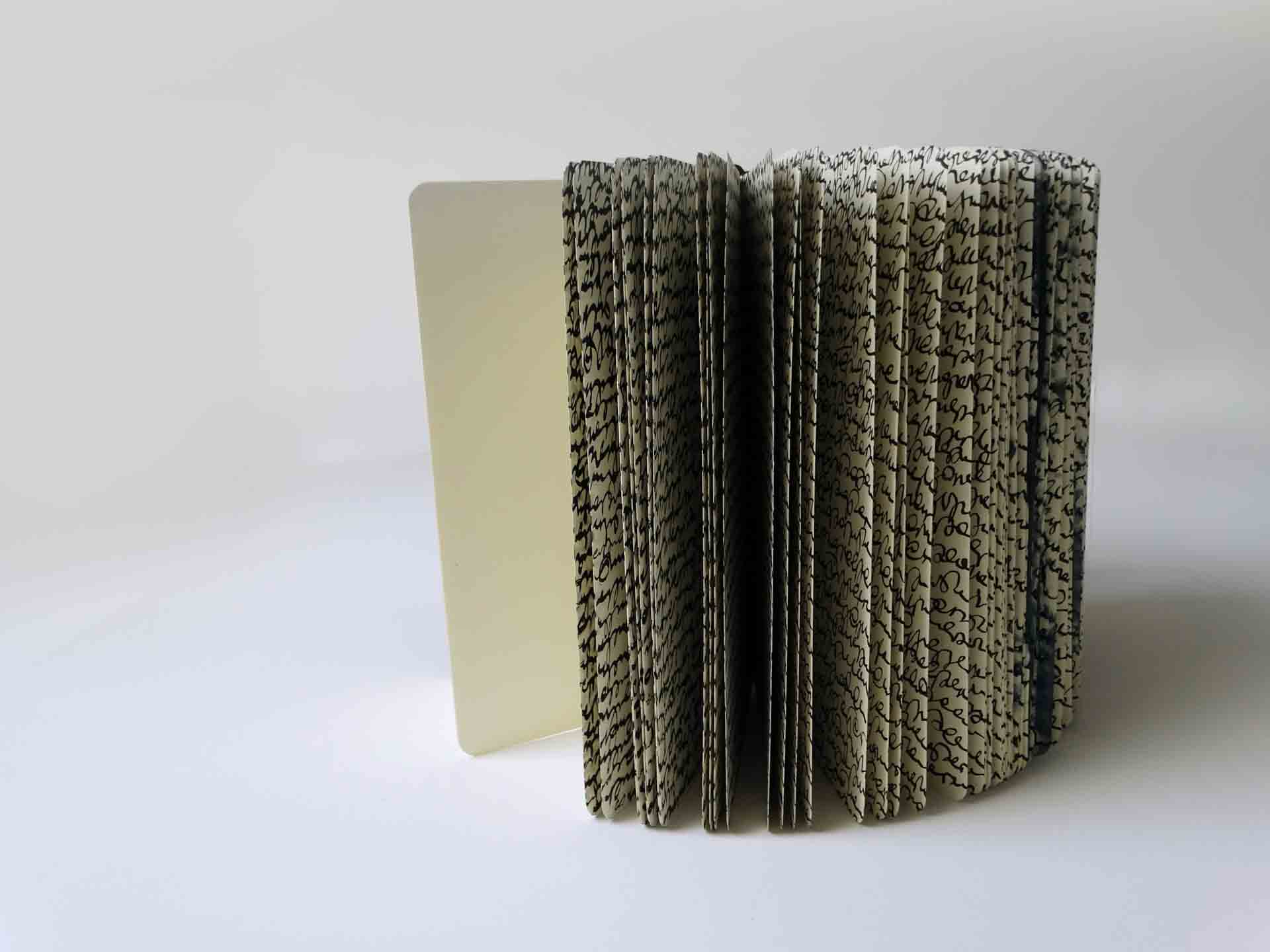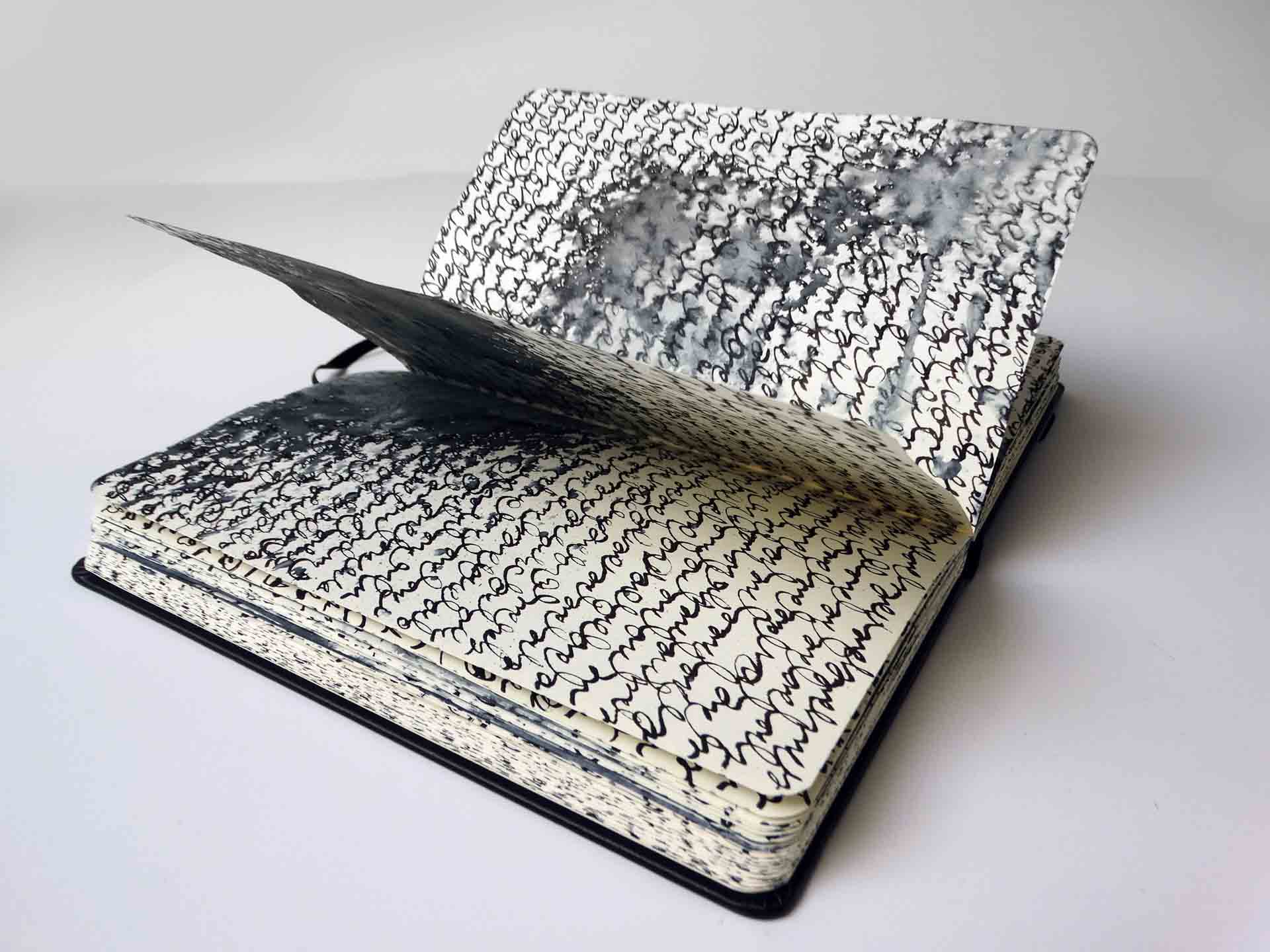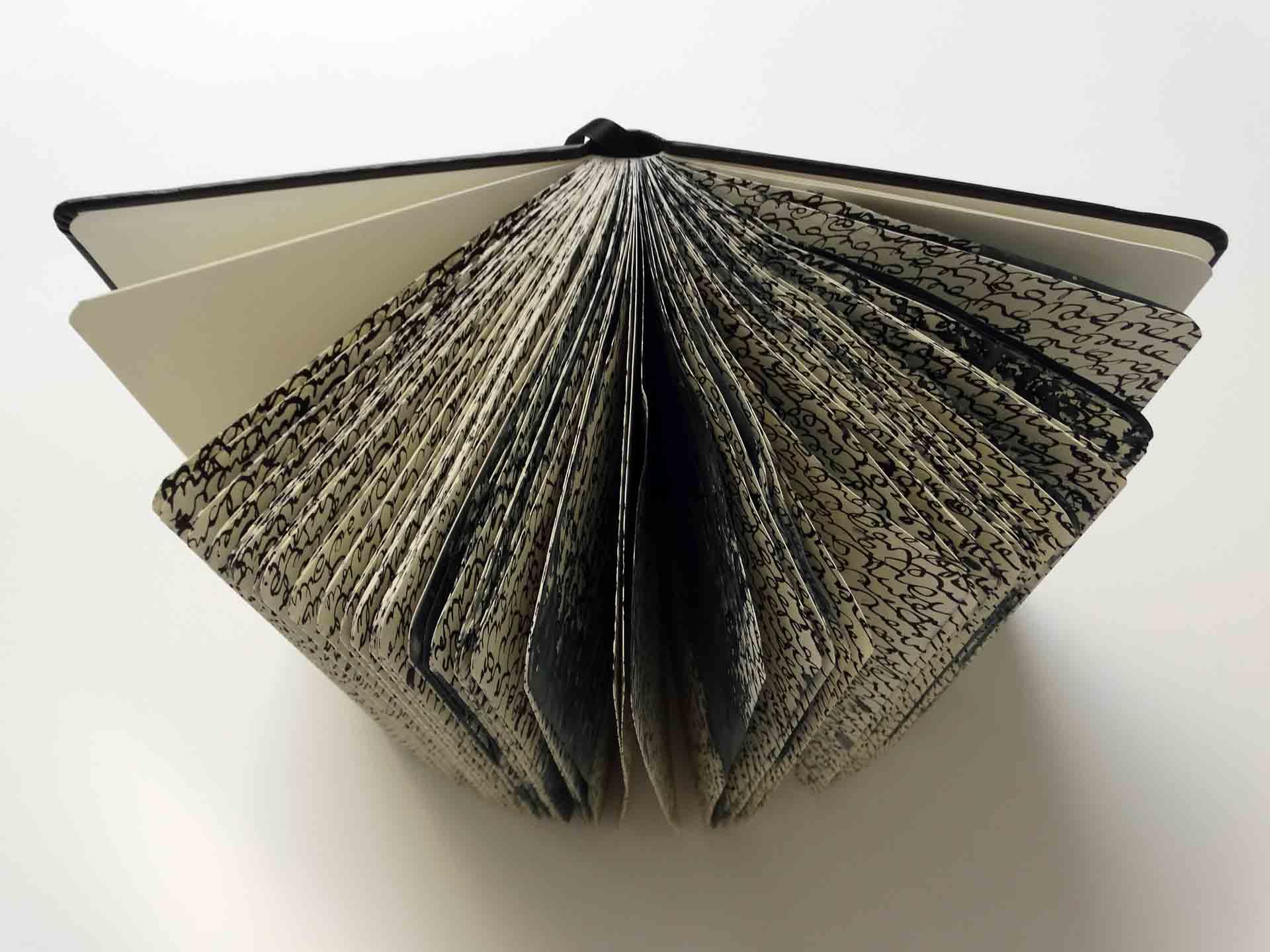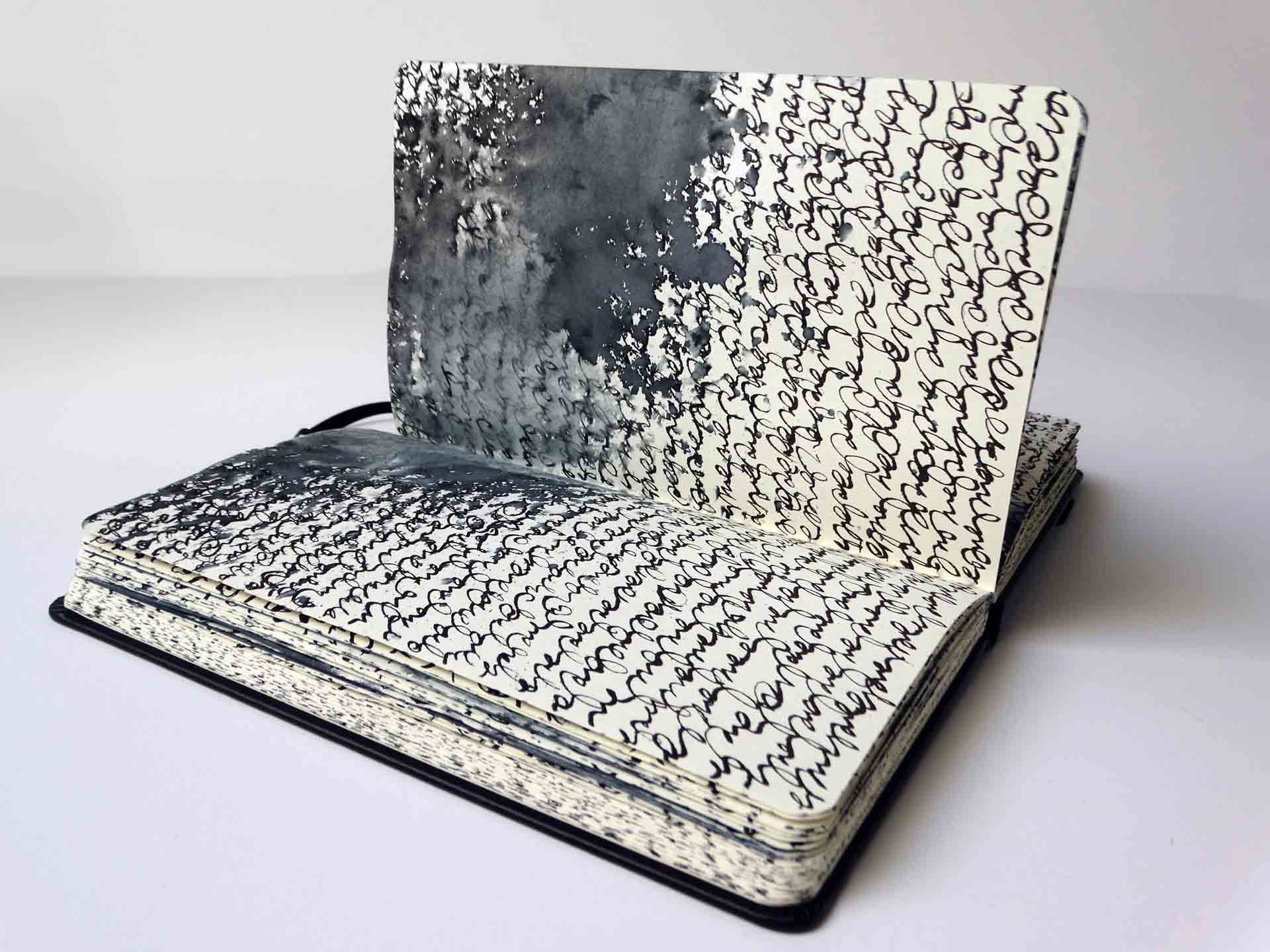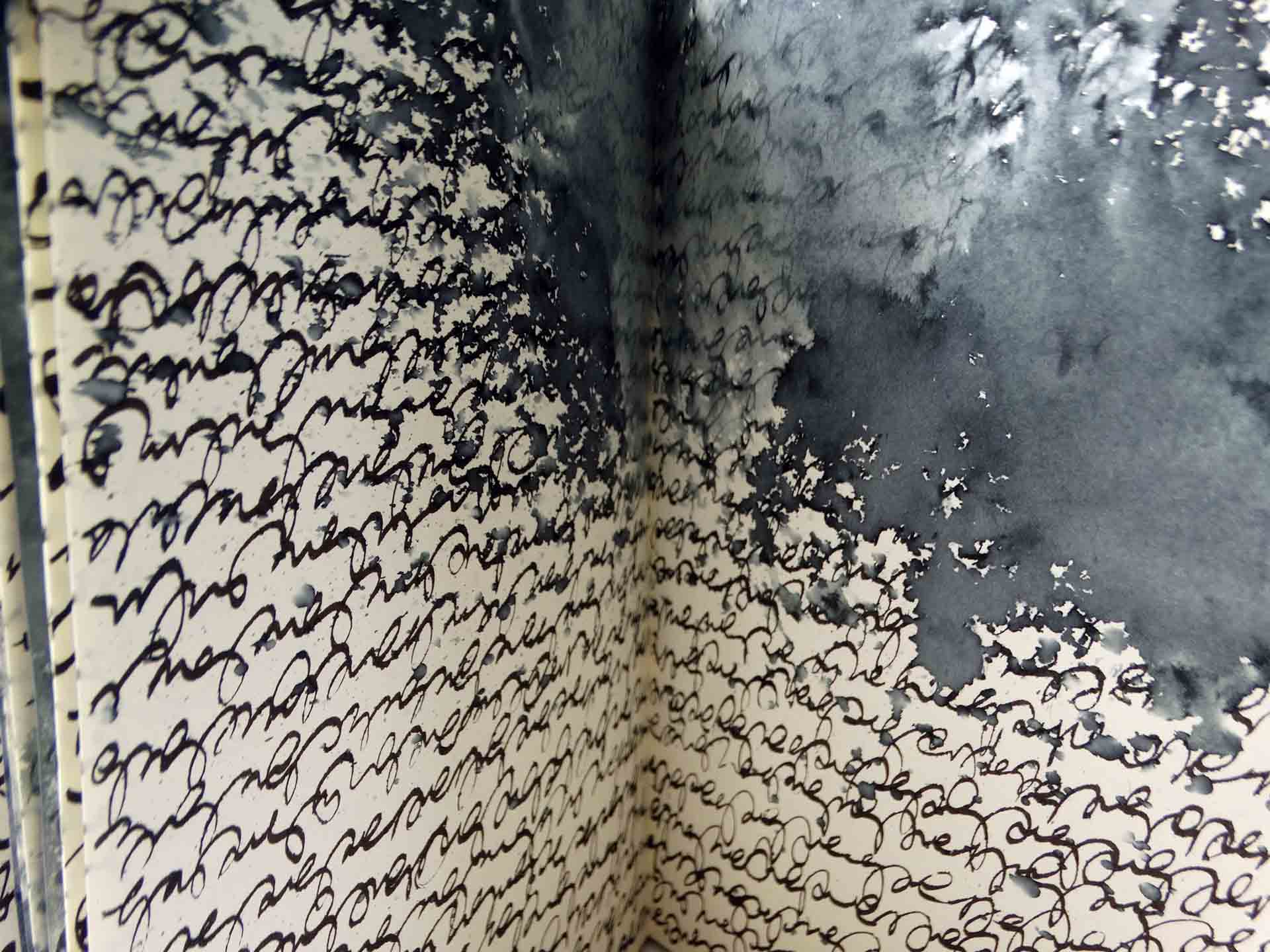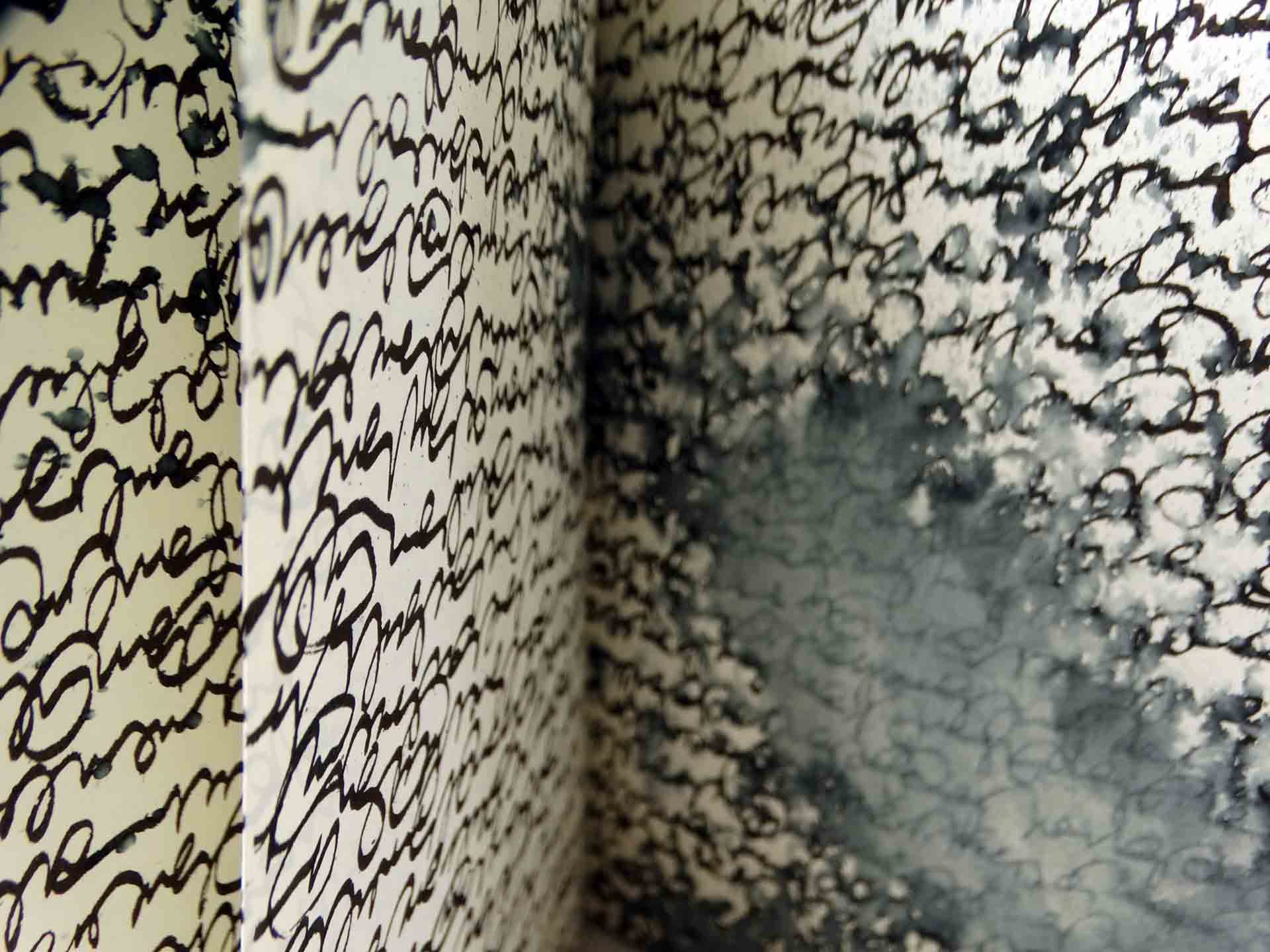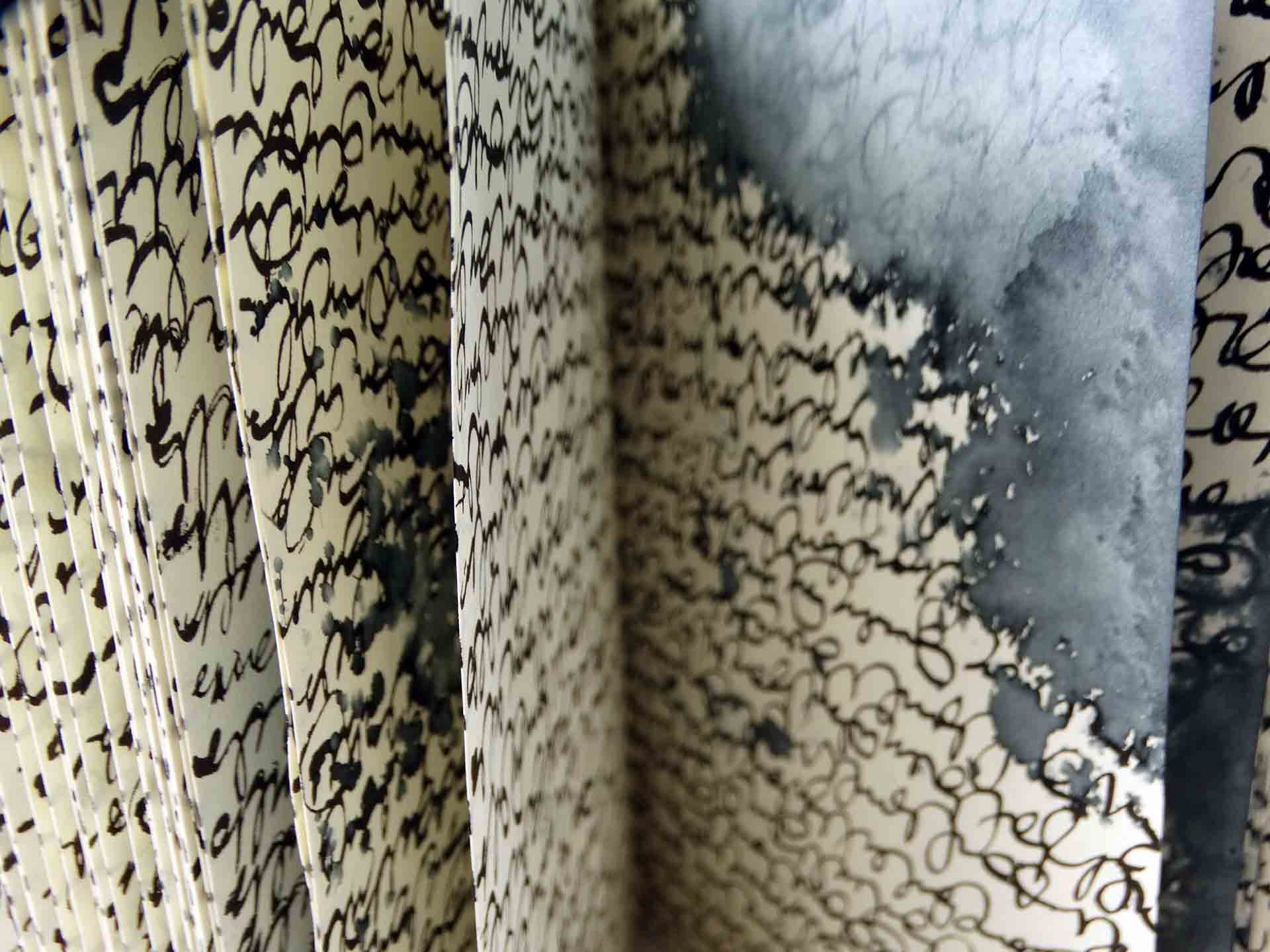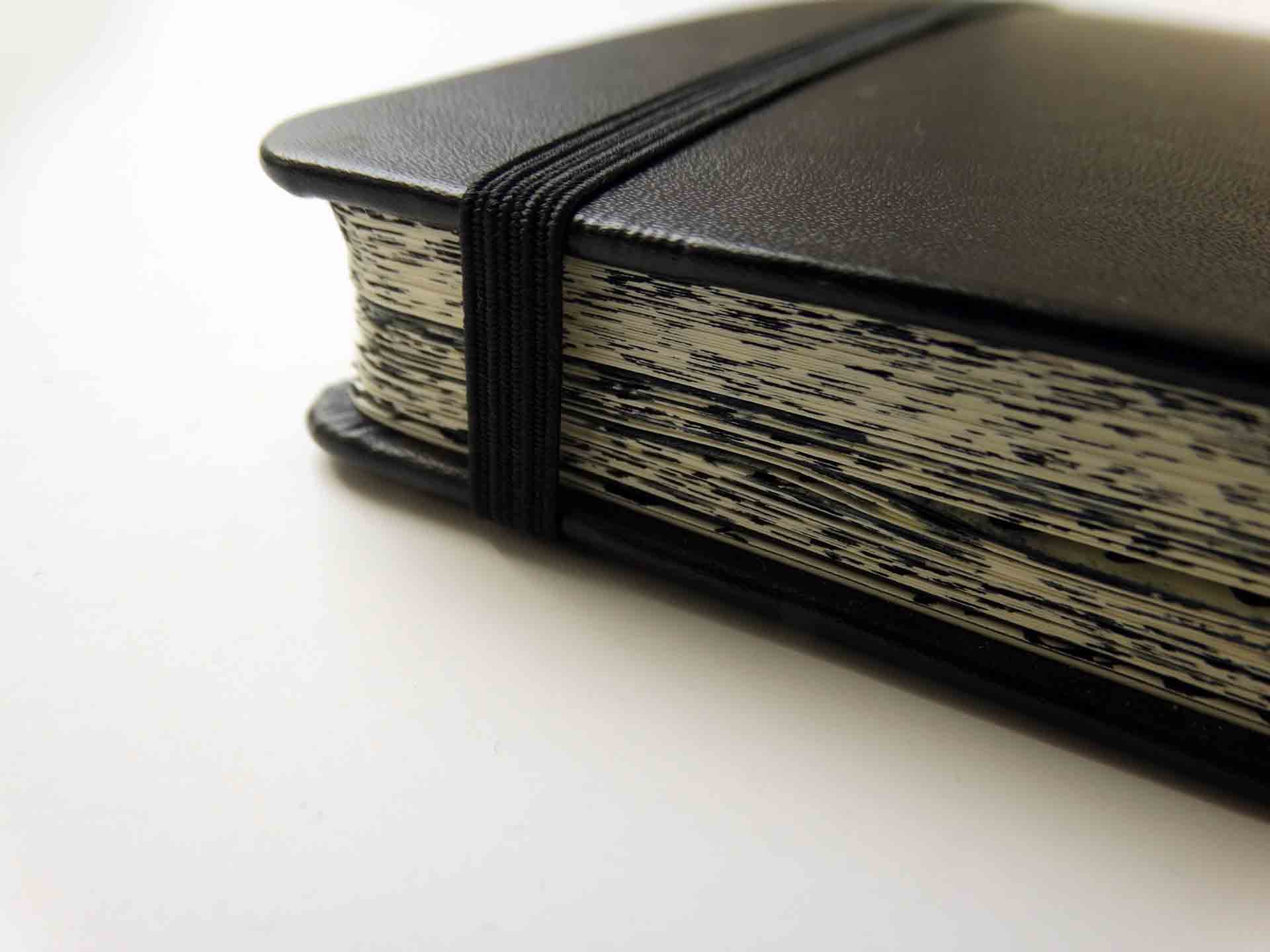Art book PANDEMICAL DIARY 3.0
From the cycle / z cyklu: ASEMIC WRITING
Art book PANDEMICAL DIARY 3.0 [11.2021-10.2022]
size: 210 x 130 mm, 160 pages
Książka artystyczna PAMIĘTNIK PANDEMICZNY 3.0 [11.2021-10.2022]
format: 210 x 130 mm, 160 stron
[ENG]
Pandemical Diary 3.0
Pandemical Diary 3.0 continues the cycle of asemic records that began in 2020 – diaries kept during a time of isolation, fear, and social suspension. At first, it was a spontaneous gesture, a response to a sudden shift in reality in which words, media images, and official communications were no longer sufficient to describe lived experience. In a world oversaturated with data and contradictory information, asemic writing becomes an attempt to capture what escapes the semantic structure of language – the gesture of the hand, the rhythm of breathing, the emotional tension of the moment.
A notation stripped of legible words produces a visual rhythm resembling writing, yet resistant to semantic translation. Each line is a kind of trace – a record of presence, but also an attempt to escape the banalization of experience. Asemia suspends communication in its traditional sense, opening a space for something more primal: gesture, trace, and emotion. For this reason, the pandemic diary is not a collection of notes nor an attempt at factual documentation. Rather, it is a pulsating surface of marks that resemble writing on one hand, but on the other hand lead beyond language, toward what cannot be expressed.
Version 3.0, covering the period from November 2021 to October 2022, is marked by an additional shadow – the outbreak of war in Ukraine. The earlier pandemic phase, dominated by isolation, fear of illness, and a sense of losing stability, was suddenly intensified by the experience of aggression, violence, and the brutal collapse of global order. Upon the surface of asemic inscriptions appeared dark stains, blurred structures of ink, traces that disturb the rhythm of writing. It is as if the material of the book itself – its paper and ink – absorbed the weight of events that could not be spoken directly.
Overlapping lines of asemic writing cut across black smears that become signs of anxiety, frustration, and helplessness. This is a visual response to the escalating chaos intruding upon individual everyday life. Where asemia had previously functioned primarily as an exercise in attentiveness and self-observation, it now becomes interrupted, contaminated, and deformed by external events. The book does not hide this fracture but makes it an integral part of its structure. In this way, it becomes not only a diary of pandemic time but also a testimony to global crisis, war trauma, and the disintegration of order that reverberates within the private sphere of experience.
Pandemical Diary 3.0 thus exists on a threshold – between inscription and asemanticity, between control and accident, between the individual gesture and the social context. Writing that could have been legible is deliberately deprived of meaning, and wherever rhythm and repetition might emerge, blotches of chaos intrude. What arises is a document that does not record facts but the intensity of experience – a document of emotions, traces, and interruptions in communication.
The artist’s book, as a medium, makes this specific form of recording possible. Enclosed within the 210 × 130 mm format and spanning 160 pages, it becomes both a material object and an intimate archive. Each page is different, yet all are governed by the general rhythm of asemia. The viewer cannot “read” it in the traditional sense, but can only look, perceive, and experience it visually and tactilely. The book draws the viewer into the intimate space of a diary, but denies access to its content – leaving only traces of writing, gestures, stains, and distortions.
In this sense, Pandemical Diary 3.0 is also a reflection on the limits of communication. Language, overloaded, becomes insufficient. Asemia proposes an alternative – a form of inscription that does not need to be understood in order to be felt. Untranslatability becomes a strength: what is unreadable, impenetrable, may still convey a state that cannot be confined to words. Both the pandemic and the war reveal that extreme experiences resist simple description, while the language of official statements often impoverishes their meaning.
Each line and each stain refers to uncertainty, but also to persistence and resilience – the act of writing despite the absence of words. It is a daily ritual, a form of existential exercise in which the process is more important than the result. The diary becomes an archive of gestures, traces of emotions, and shifting states of awareness. It is a testimony of both helplessness and strength – a strength found in the continuation of writing, in persisting with the act even when words prove inadequate.
Pandemical Diary 3.0 can thus be read as a document of an age of crises – personal and global, pandemic and wartime. Yet it may also be regarded as a contemplative form of art that probes the thresholds between language and asemanticity, between the private and the public, between control and chaos. It is a book of traces that offers no answers, but opens a space for reflection – on the fragility of existence, on the power of gesture, and on the necessity of recording, even in the most uncertain times, to preserve a memory of that which eludes words.
[PL]
Pamiętnik pandemiczny 3.0
Pamiętnik pandemiczny 3.0 kontynuuje rozpoczęty w 2020 roku cykl asemicznych zapisków – dzienników prowadzonych w czasie izolacji, lęku i społecznego zawieszenia. Początkowo był to gest spontaniczny, odpowiedź na nagłą zmianę rzeczywistości, w której słowa, obrazy medialne i oficjalne komunikaty przestały być wystarczające do opisu doświadczenia. W świecie nadmiaru danych i sprzecznych informacji, asemiczne pismo staje się próbą uchwycenia tego, co wymyka się semantycznej strukturze języka – gestu ręki, rytmu oddechu, emocjonalnego napięcia chwili.
Notacja pozbawiona czytelnych słów tworzy wizualny rytm przypominający zapis, lecz nieprzekładalny na język semantyczny. Każda linia jest rodzajem śladu – zapisem obecności, ale i próbą ucieczki od banalizacji doświadczenia. Asemia unieważnia komunikat w jego tradycyjnym sensie, otwierając przestrzeń na coś bardziej pierwotnego: na gest, ślad i emocję. Właśnie dlatego dziennik pandemiczny nie jest zbiorem notatek ani próbą dokumentowania faktów. To raczej pulsująca powierzchnia znaków, które z jednej strony są bliskie pismu, a z drugiej – prowadzą poza język, w kierunku tego, co niewyrażalne.
Wersja 3.0, obejmująca okres od listopada 2021 do października 2022 roku, została jednak naznaczona dodatkowym cieniem – wybuchem wojny w Ukrainie. Wcześniejsza faza pandemiczna, zdominowana przez izolację, lęk o zdrowie i poczucie utraty stabilności, została nagle wzmocniona przez doświadczenie agresji, przemocy i brutalnego zerwania ładu światowego. Na warstwie asemicznych zapisów pojawiły się ciemne plamy, rozlane struktury tuszu, ślady, które zakłócają rytm pisma. To jakby sam materiał książki, jej papier i tusz, przyjął na siebie ciężar wydarzeń, których nie sposób wyrazić wprost.
Nakładające się na siebie linie asemicznego pisma przecinają czarne rozmycia, które stają się znakami niepokoju, frustracji i bezsilności. To wizualna odpowiedź na narastający chaos, wdzierający się w indywidualną codzienność. Tam, gdzie wcześniej asemia była przede wszystkim ćwiczeniem uważności i autoobserwacji, teraz zostaje przerwana, zanieczyszczona i zdeformowana przez zewnętrzne wydarzenia. Książka nie ukrywa tego pęknięcia, lecz czyni z niego element swojej struktury. W ten sposób staje się nie tylko pamiętnikiem czasu pandemii, ale i świadectwem globalnego kryzysu, wojennej traumy i rozpadu porządku, które rezonują także w przestrzeni prywatnego doświadczenia.
Pamiętnik pandemiczny 3.0 funkcjonuje na granicy – między zapisem a asemantycznością, między kontrolą a przypadkiem, między indywidualnym gestem a społecznym kontekstem. Pismo, które mogłoby być czytelne, zostaje świadomie pozbawione znaczenia, a tam, gdzie pojawia się przestrzeń dla rytmu i powtarzalności, wdzierają się plamy chaosu. Tak powstaje dokument, który nie rejestruje faktów, lecz intensywność doświadczenia – dokument emocji, śladów i przerw w komunikacji.
Książka artystyczna, jako medium, umożliwia tę szczególną formę zapisu. Zamknięta w formacie 210 × 130 mm, licząca 160 stron, staje się zarówno obiektem materialnym, jak i intymnym archiwum. Każda strona jest inna, a jednocześnie podporządkowana ogólnemu rytmowi asemii. Odbiorca nie może jej „przeczytać” w tradycyjnym sensie, lecz może ją oglądać, doświadczać wizualnie i dotykowo. Książka wprowadza go w intymną przestrzeń pamiętnika, nie dając jednak dostępu do treści – zostawiając jedynie ślady po pisaniu, gestach, plamach i deformacjach.
W tym sensie Pamiętnik pandemiczny 3.0 to także refleksja nad granicami komunikacji. Język, zbyt obciążony, staje się niewystarczający. Asemia proponuje alternatywę – zapis, który nie musi być rozumiany, by był odczuwany. Nieprzetłumaczalność staje się tu siłą: to, co nieczytelne, nieprzeniknione, może wyrazić stan, którego nie da się zamknąć w słowach. Pandemia i wojna pokazują bowiem, że doświadczenia graniczne wymykają się prostemu opisowi, a język oficjalnych komunikatów często zubaża ich sens.
Każda linia i każda plama odsyła do niepewności, ale też do trwania i uporu – aktu zapisywania mimo braku słów. To codzienny rytuał, rodzaj ćwiczenia egzystencjalnego, w którym ważniejszy jest sam proces niż rezultat. Pamiętnik staje się archiwum gestów, śladów emocji i zmiennych stanów świadomości. Jest świadectwem zarówno bezradności, jak i siły – siły, która polega na kontynuowaniu zapisu, na trwaniu przy akcie pisania nawet wtedy, gdy słowa okazują się niewystarczające.
Pamiętnik pandemiczny 3.0 można więc odczytywać jako dokument epoki kryzysów – osobistych i globalnych, pandemicznych i wojennych. Ale można też traktować go jako formę sztuki kontemplacyjnej, która bada granice między językiem i asemantycznością, między prywatnym i publicznym, między kontrolą a chaosem. To księga śladów, która nie daje odpowiedzi, lecz otwiera przestrzeń do refleksji – o kruchości istnienia, sile gestu i o tym, że nawet w najbardziej niepewnych czasach warto zapisywać, by zachować pamięć o tym, co wymyka się słowom.
